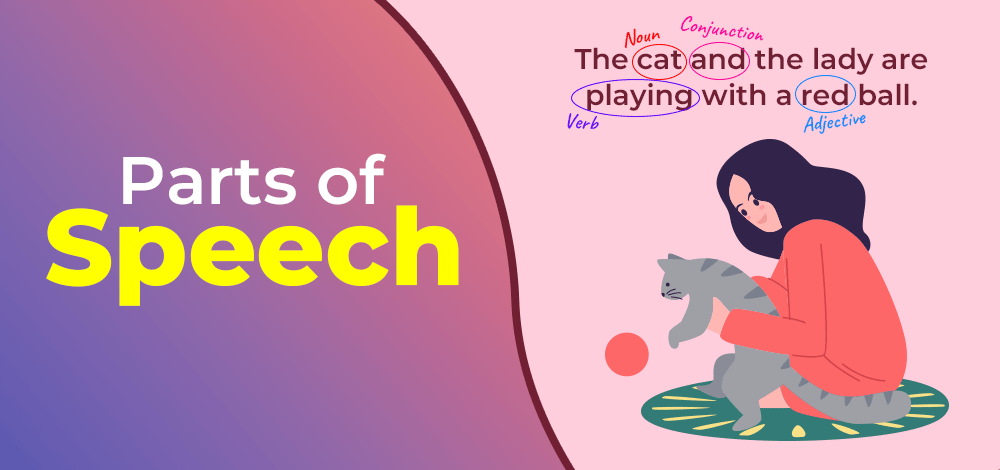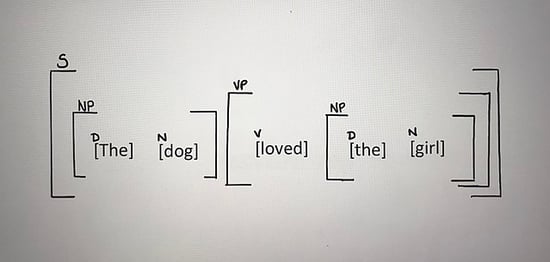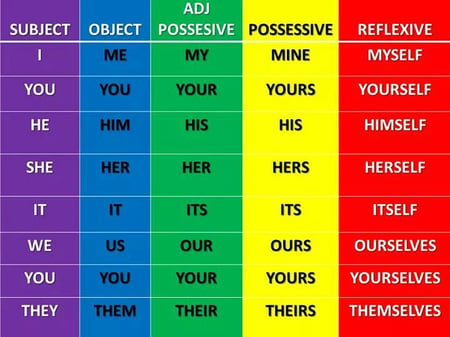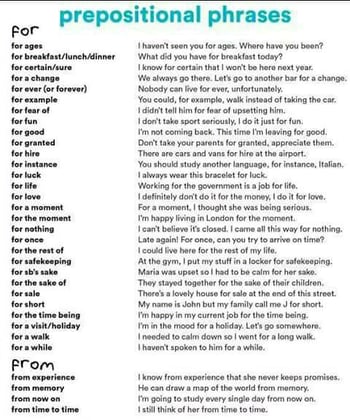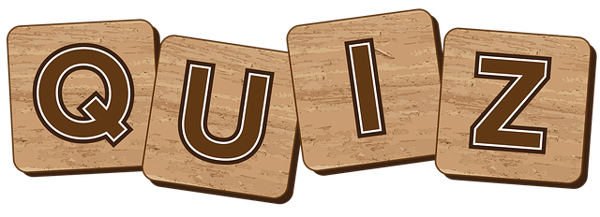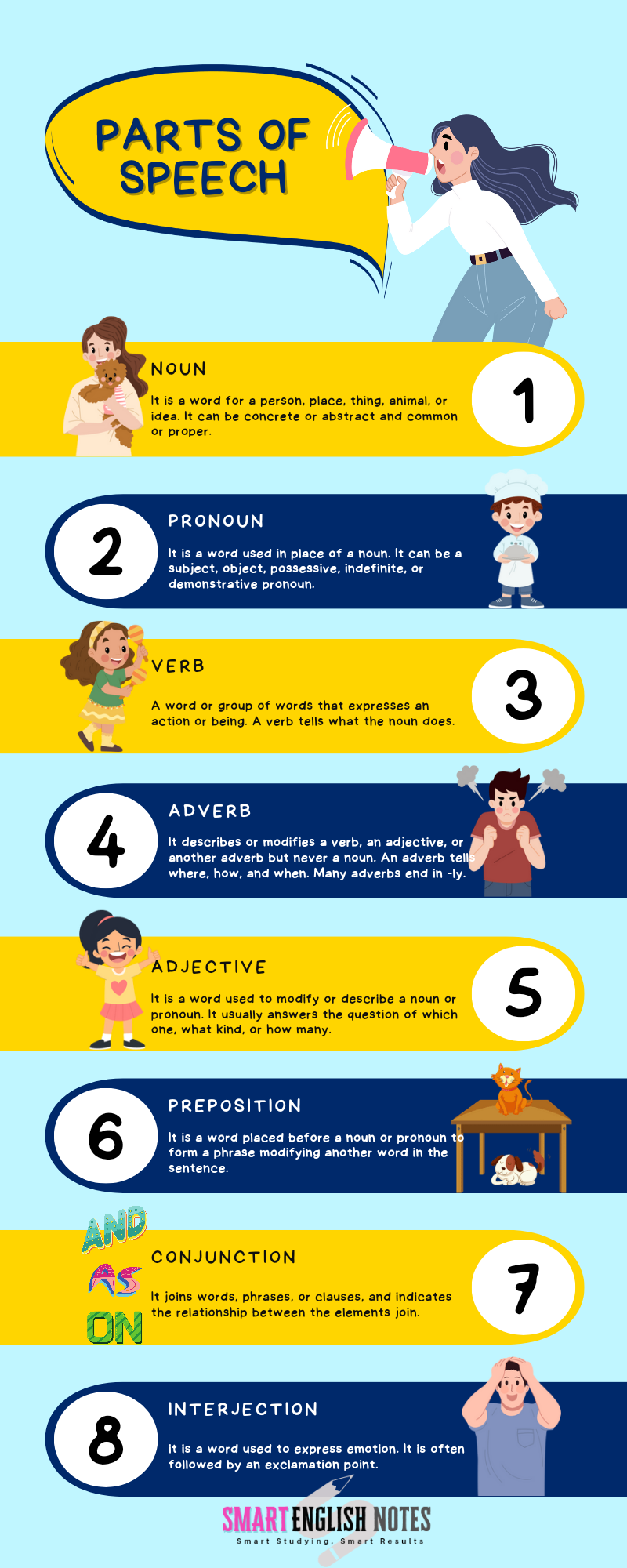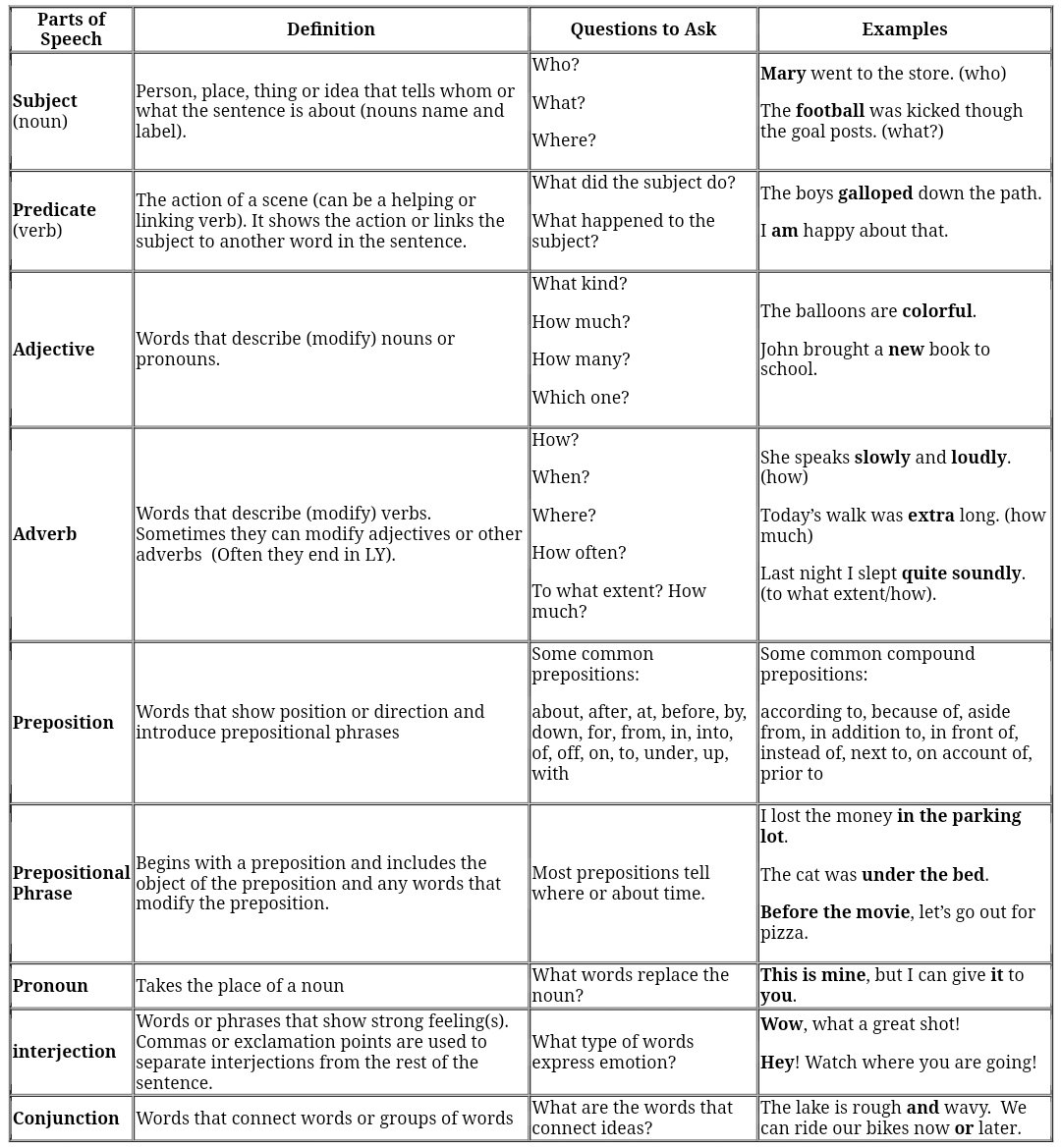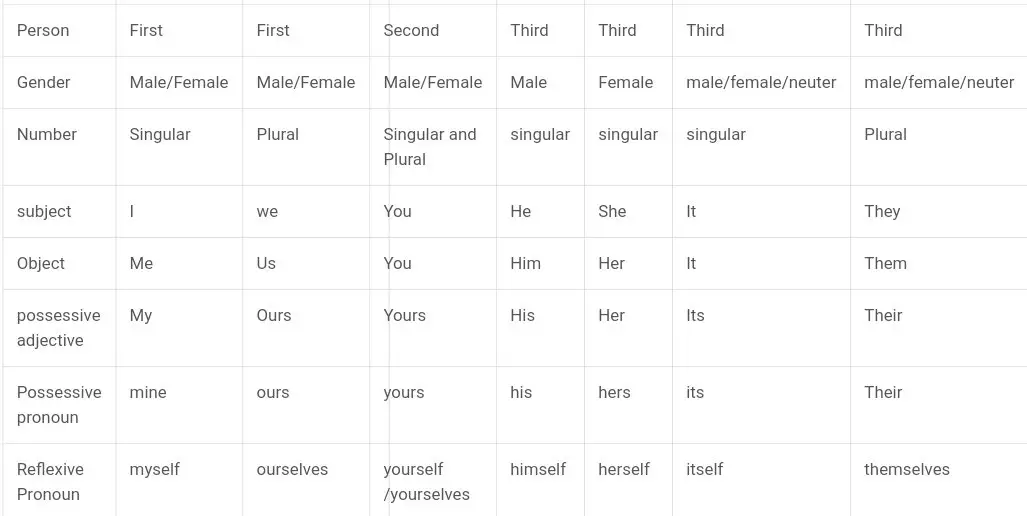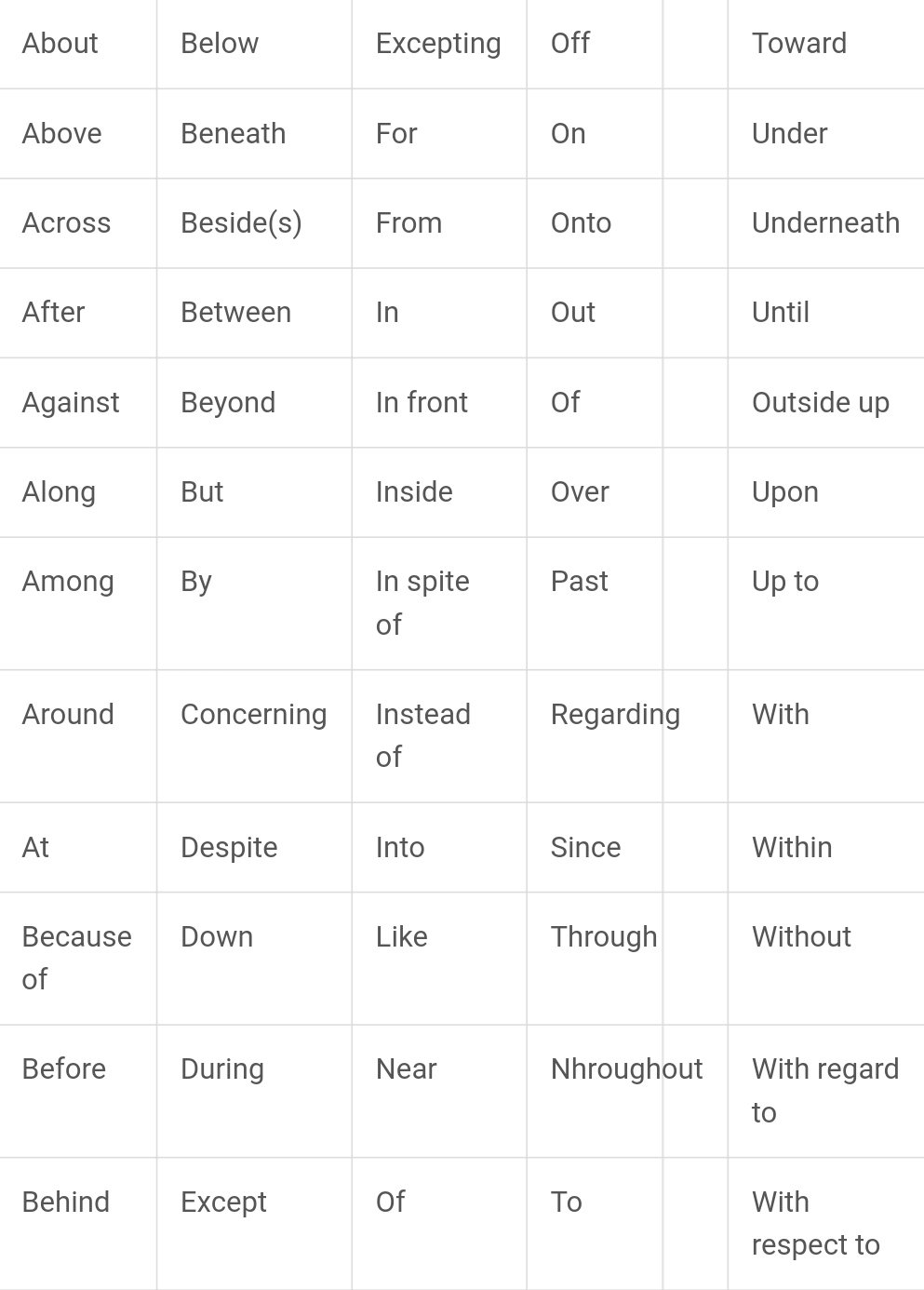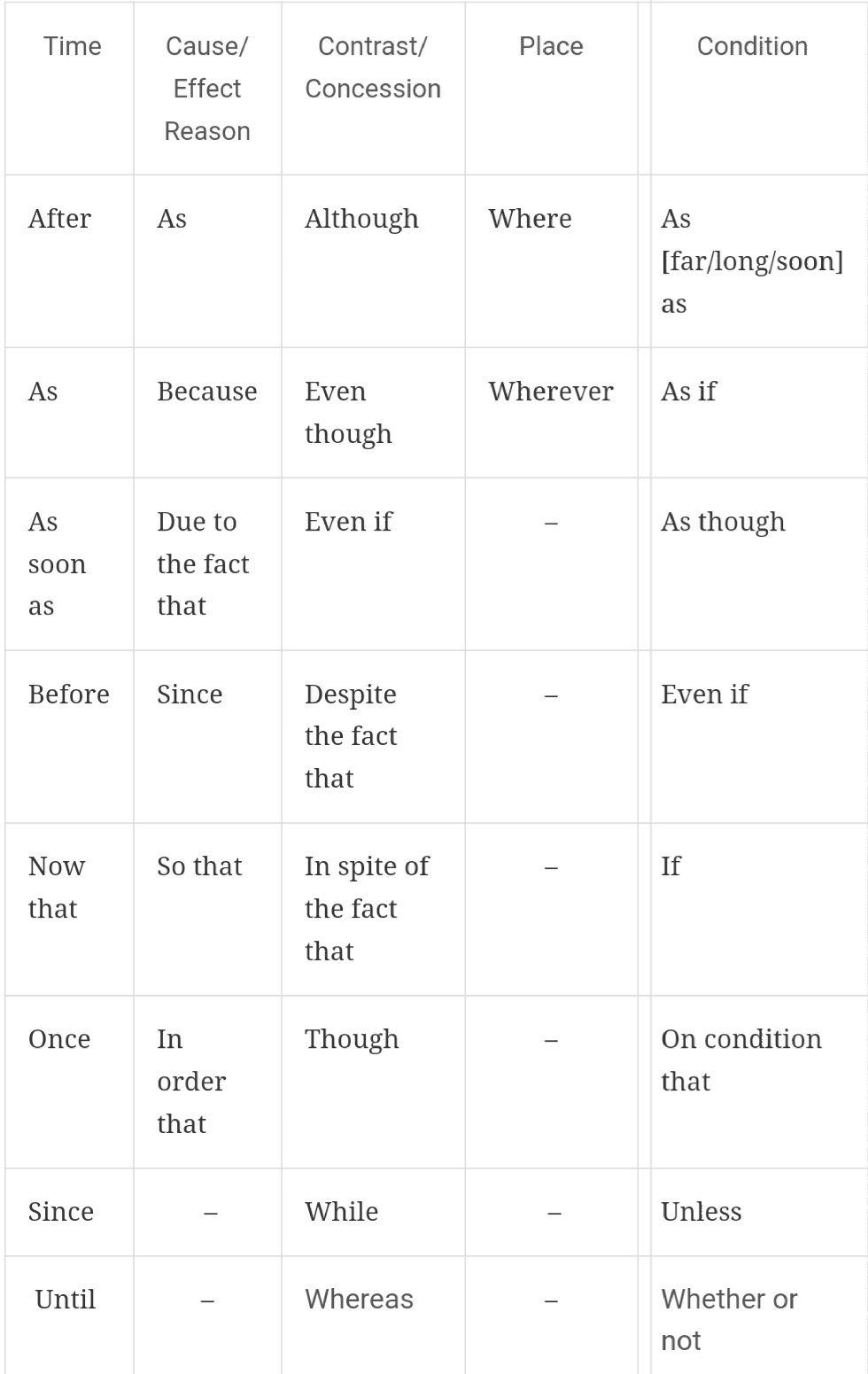A part of speech is a term used in traditional grammar for one of the nine main categories into which words are classified according to their functions in sentences, such as nouns or verbs. Also known as word classes, these are the building blocks of grammar.
Parts of Speech
- Word types can be divided into nine parts of speech:
- nouns
- pronouns
- verbs
- adjectives
- adverbs
- prepositions
- conjunctions
- articles/determiners
- interjections
- Some words can be considered more than one part of speech, depending on context and usage.
- Interjections can form complete sentences on their own.
Every sentence you write or speak in English includes words that fall into some of the nine parts of speech. These include nouns, pronouns, verbs, adjectives, adverbs, prepositions, conjunctions, articles/determiners, and interjections. (Some sources include only eight parts of speech and leave interjections in their own category.)
Learning the names of the parts of speech probably won’t make you witty, healthy, wealthy, or wise. In fact, learning just the names of the parts of speech won’t even make you a better writer. However, you will gain a basic understanding of sentence structure and the English language by familiarizing yourself with these labels.
Open and Closed Word Classes
The parts of speech are commonly divided into open classes (nouns, verbs, adjectives, and adverbs) and closed classes (pronouns, prepositions, conjunctions, articles/determiners, and interjections). The idea is that open classes can be altered and added to as language develops and closed classes are pretty much set in stone. For example, new nouns are created every day, but conjunctions never change.
In contemporary linguistics, the label part of speech has generally been discarded in favor of the term word class or syntactic category. These terms make words easier to qualify objectively based on word construction rather than context. Within word classes, there is the lexical or open class and the function or closed class.
Read about each part of speech below and get started practicing identifying each.
Noun
Nouns are a person, place, thing, or idea. They can take on a myriad of roles in a sentence, from the subject of it all to the object of an action. They are capitalized when they’re the official name of something or someone, called proper nouns in these cases. Examples: pirate, Caribbean, ship, freedom, Captain Jack Sparrow.
Pronoun
Pronouns stand in for nouns in a sentence. They are more generic versions of nouns that refer only to people. Examples: I, you, he, she, it, ours, them, who, which, anybody, ourselves.
Verb
Verbs are action words that tell what happens in a sentence. They can also show a sentence subject’s state of being (is, was). Verbs change form based on tense (present, past) and count distinction (singular or plural). Examples: sing, dance, believes, seemed, finish, eat, drink, be, became
Adjective
Adjectives describe nouns and pronouns. They specify which one, how much, what kind, and more. Adjectives allow readers and listeners to use their senses to imagine something more clearly. Examples: hot, lazy, funny, unique, bright, beautiful, poor, smooth.
Adverb
Adverbs describe verbs, adjectives, and even other adverbs. They specify when, where, how, and why something happened and to what extent or how often. Examples: softly, lazily, often, only, hopefully, softly, sometimes.
Preposition
Prepositions show spacial, temporal, and role relations between a noun or pronoun and the other words in a sentence. They come at the start of a prepositional phrase, which contains a preposition and its object. Examples: up, over, against, by, for, into, close to, out of, apart from.
Conjunction
Conjunctions join words, phrases, and clauses in a sentence. There are coordinating, subordinating, and correlative conjunctions. Examples: and, but, or, so, yet, with.
Articles and Determiners
Articles and determiners function like adjectives by modifying nouns, but they are different than adjectives in that they are necessary for a sentence to have proper syntax. Articles and determiners specify and identify nouns, and there are indefinite and definite articles. Examples: articles: a, an, the; determiners: these, that, those, enough, much, few, which, what.
Some traditional grammars have treated articles as a distinct part of speech. Modern grammars, however, more often include articles in the category of determiners, which identify or quantify a noun. Even though they modify nouns like adjectives, articles are different in that they are essential to the proper syntax of a sentence, just as determiners are necessary to convey the meaning of a sentence, while adjectives are optional.
Interjection
Interjections are expressions that can stand on their own or be contained within sentences. These words and phrases often carry strong emotions and convey reactions. Examples: ah, whoops, ouch, yabba dabba do!
How to Determine the Part of Speech
Only interjections (Hooray!) have a habit of standing alone; every other part of speech must be contained within a sentence and some are even required in sentences (nouns and verbs). Other parts of speech come in many varieties and may appear just about anywhere in a sentence.
To know for sure what part of speech a word falls into, look not only at the word itself but also at its meaning, position, and use in a sentence.
For example, in the first sentence below, work functions as a noun; in the second sentence, a verb; and in the third sentence, an adjective:
- Bosco showed up for work two hours late.
- The noun work is the thing Bosco shows up for.
- He will have to work until midnight.
- The verb work is the action he must perform.
- His work permit expires next month.
- The attributive noun [or converted adjective] work modifies the noun permit.
Learning the names and uses of the basic parts of speech is just one way to understand how sentences are constructed.
Dissecting Basic Sentences
To form a basic complete sentence, you only need two elements: a noun (or pronoun standing in for a noun) and a verb. The noun acts as a subject and the verb, by telling what action the subject is taking, acts as the predicate.
- Birds fly.
In the short sentence above, birds is the noun and fly is the verb. The sentence makes sense and gets the point across.
You can have a sentence with just one word without breaking any sentence formation rules. The short sentence below is complete because it’s a command to an understood «you».
- Go!
Here, the pronoun, standing in for a noun, is implied and acts as the subject. The sentence is really saying, «(You) go!»
Constructing More Complex Sentences
Use more parts of speech to add additional information about what’s happening in a sentence to make it more complex. Take the first sentence from above, for example, and incorporate more information about how and why birds fly.
- Birds fly when migrating before winter.
Birds and fly remain the noun and the verb, but now there is more description.
When is an adverb that modifies the verb fly. The word before is a little tricky because it can be either a conjunction, preposition, or adverb depending on the context. In this case, it’s a preposition because it’s followed by a noun. This preposition begins an adverbial phrase of time (before winter) that answers the question of when the birds migrate. Before is not a conjunction because it does not connect two clauses.
Parts of Speech
Every word is a part of speech, each playing a specific role in a sentence. There are 8 different parts of speech including noun, verb, adjective, adverb, pronoun, preposition, conjunction, and interjection. Each word in a sentence plays a vital role in conveying the meaning and intent of the sentence.
What is Part of Speech?
The English language has thousands of words and every word has some function to perform. Some words are there to show action, some to join, and some to name something. And together, all the functions performed by words in the English language fall under Parts of speech.
Parts of Speech Definition
The parts of speech are the “traditional grammatical categories to which words are assigned in accordance with their syntactic functions, such as noun, verb, adjective, adverb, and so on.” In other words, they refer to the different roles that words can play in a sentence and how they relate to one another based on grammar and syntax.
Parts of Speech Table
| Types | Function | Examples | Sentences |
| Noun | Refers Things or person | Pen, Chair, Ram, Honesty |
Cars are expensive. This chair is of wood. Ram is a topper. Honesty is the best policy. |
| Pronoun | Replaces a noun | I, you, he, she, it, they |
They are expensive. It is of wood. He is a topper. It is the best policy |
| Adjective | Describes a noun |
Super, Red, Our, Big, Great class |
Super cars are expensive Red chair is for kids Ram is a class topper. Great things take time. |
| Verb | Describes action or state | Play, be, work, love, like |
I play football I will be a doctor I like to work I love writing poem. |
| Adverb | Describes a verb, adjective or adverb | Silently, too, very |
I love reading silently. It is too tough to handle. He can speak very fast. |
| Preposition | Links a noun to another word | at, in, of, after, under, |
The ball is under the table. I am at a restaurant. she is in trouble. I am going after her. It is so nice of him |
| Conjunction | Joins clauses and sentences | and, but, though, after |
First, I will go to college and then I may go to fest. I don’t have a car but I know how to drive. She failed the exam though she worked hard. He will come after he finish his match. |
| Interjection | Shows exclamation | oh!, wow!, alas! Hurray! |
Oh! I got fail again. Wow! I got the job. Alas! She is no more. Hurray! we are going to party. |
Parts of Speech Examples with Sentences
Noun
Examples: Luggage, Cattle.
Sentence: Never leave your luggage unattended.
In some places, cattle are fed barely.
Pronoun
Examples: who, either, themselves
Sentence: I know a man who plays the guitar very well.
Either of the two cars is for sale.
They enjoyed themselves at the party.
Adjective
Examples: kind, moving, wounder.
Sentence:
She is a kind person.
Boarding a moving bus can be dangerous.
Never poke a wounded animal.
Verb
Examples: Praise, Hate, Punish
Sentence: She always praises her friends.
I don’t hate anybody.
The boy has been punished by his teacher
Adverb
Examples: Always, enough, immediately
Sentence: we should always help each other.
We should be wise enough to understand what is good for us.
We should leave bad habits immediately.
Preposition
Examples: Off, Below, From. to
Sentence:
He plunged off the cliff
I live below the 9th floor.
I travel daily from Delhi to Noida.
Conjunction
Examples: whereas, as well as, so,
Sentence: The new software is fairly simple whereas the old one was a bit complicated.
The finance company is not performing well as well as some of its competitors.
He was ready so he may come.
Interjection
Examples: oops! whoa! phew!
Sentence: Oops! I forgot to mention her name.
Whoa! you drive fast.
Phew! That was close call, we had a narrow escape.
Parts of Speech Quiz
Choose the correct Parts of Speech of the BOLD word from the following questions.
1. Let us play, Shall We?
a. Conjunction
b. Pronoun
c. Verb
2. It is a good practice to arrange books on shelves.
a. Verb
b. Noun
c. Adjective
3. Whose books are these?
a. Pronoun
b. Preposition
c. verb
4. Father, please get me that toy.
a. Pronoun
b. Adverb
c. Adjective
5. His mentality is rather obnoxious.
a. Adverb
b. Adjective
c. Noun
6. He is the guy whose money got stolen.
a. Pronoun
b. Conjunction
c. Adjective
7. I will have finished my semester by the end of this year.
a. Interjection
b. Conjunction
c. Preposition
8. Bingo! That’s the one I have been looking for
a. Interjection
b. Conjunction
c. Preposition
Quiz Answers
1. c, 2. b, 3. a, 4. c, 5. a, 6. b, 7. c, 8. a
FAQs on Parts of Speech
Q1. What are Parts of Speech?
Ans. A word is assigned to a category as per its function, and those categories are together known as Parts of Speech.
Q2. What are the 8 Parts of Speech?
Ans. Noun, Pronoun, Adjective, Verb, Adverb, Preposition, Conjunction, Interjection.
Q3. How many Parts of Speech are there?
Ans. There are a total of 8 parts of Speech.
Q4. What Part of Speech is “our”?
Ans. Adjective. Eg. Our car.
Q5. What Part of Speech is “Quickly”?
Ans. Adverb. let us understand it with this example – Milk sours quickly in warm weather.
If you’re trying to learn the grammatical rules of English, you’ve probably been asked to learn the parts of speech. But what are parts of speech and how many are there? How do you know which words are classified in each part of speech?
The answers to these questions can be a bit complicated—English is a difficult language to learn and understand. Don’t fret, though! We’re going to answer each of these questions for you with a full guide to the parts of speech that explains the following:
- What the parts of speech are, including a comprehensive parts of speech list
- Parts of speech definitions for the individual parts of speech. (If you’re looking for information on a specific part of speech, you can search for it by pressing Command + F, then typing in the part of speech you’re interested in.)
- Parts of speech examples
- A ten question quiz covering parts of speech definitions and parts of speech examples
We’ve got a lot to cover, so let’s begin!
Feature Image: (Gavina S / Wikimedia Commons)
What Are Parts of Speech?
The parts of speech definitions in English can vary, but here’s a widely accepted one: a part of speech is a category of words that serve a similar grammatical purpose in sentences.
To make that definition even simpler, a part of speech is just a category for similar types of words. All of the types of words included under a single part of speech function in similar ways when they’re used properly in sentences.
In the English language, it’s commonly accepted that there are 8 parts of speech: nouns, verbs, adjectives, adverbs, pronouns, conjunctions, interjections, and prepositions. Each of these categories plays a different role in communicating meaning in the English language. Each of the eight parts of speech—which we might also call the “main classes” of speech—also have subclasses. In other words, we can think of each of the eight parts of speech as being general categories for different types within their part of speech. There are different types of nouns, different types of verbs, different types of adjectives, adverbs, pronouns…you get the idea.
And that’s an overview of what a part of speech is! Next, we’ll explain each of the 8 parts of speech—definitions and examples included for each category.
There are tons of nouns in this picture. Can you find them all?
#1: Nouns
Nouns are a class of words that refer, generally, to people and living creatures, objects, events, ideas, states of being, places, and actions. You’ve probably heard English nouns referred to as “persons, places, or things.” That definition is a little simplistic, though—while nouns do include people, places, and things, “things” is kind of a vague term. It’s important to recognize that “things” can include physical things—like objects or belongings—and nonphysical, abstract things—like ideas, states of existence, and actions.
Since there are many different types of nouns, we’ll include several examples of nouns used in a sentence while we break down the subclasses of nouns next!
Subclasses of Nouns, Including Examples
As an open class of words, the category of “nouns” has a lot of subclasses. The most common and important subclasses of nouns are common nouns, proper nouns, concrete nouns, abstract nouns, collective nouns, and count and mass nouns. Let’s break down each of these subclasses!
Common Nouns and Proper Nouns
Common nouns are generic nouns—they don’t name specific items. They refer to people (the man, the woman), living creatures (cat, bird), objects (pen, computer, car), events (party, work), ideas (culture, freedom), states of being (beauty, integrity), and places (home, neighborhood, country) in a general way.
Proper nouns are sort of the counterpart to common nouns. Proper nouns refer to specific people, places, events, or ideas. Names are the most obvious example of proper nouns, like in these two examples:
Common noun: What state are you from?
Proper noun: I’m from Arizona.
Whereas “state” is a common noun, Arizona is a proper noun since it refers to a specific state. Whereas “the election” is a common noun, “Election Day” is a proper noun. Another way to pick out proper nouns: the first letter is often capitalized. If you’d capitalize the word in a sentence, it’s almost always a proper noun.
Concrete Nouns and Abstract Nouns
Concrete nouns are nouns that can be identified through the five senses. Concrete nouns include people, living creatures, objects, and places, since these things can be sensed in the physical world. In contrast to concrete nouns, abstract nouns are nouns that identify ideas, qualities, concepts, experiences, or states of being. Abstract nouns cannot be detected by the five senses. Here’s an example of concrete and abstract nouns used in a sentence:
Concrete noun: Could you please fix the weedeater and mow the lawn?
Abstract noun: Aliyah was delighted to have the freedom to enjoy the art show in peace.
See the difference? A weedeater and the lawn are physical objects or things, and freedom and peace are not physical objects, though they’re “things” people experience! Despite those differences, they all count as nouns.
Collective Nouns, Count Nouns, and Mass Nouns
Nouns are often categorized based on number and amount. Collective nouns are nouns that refer to a group of something—often groups of people or a type of animal. Team, crowd, and herd are all examples of collective nouns.
Count nouns are nouns that can appear in the singular or plural form, can be modified by numbers, and can be described by quantifying determiners (e.g. many, most, more, several). For example, “bug” is a count noun. It can occur in singular form if you say, “There is a bug in the kitchen,” but it can also occur in the plural form if you say, “There are many bugs in the kitchen.” (In the case of the latter, you’d call an exterminator…which is an example of a common noun!) Any noun that can accurately occur in one of these singular or plural forms is a count noun.
Mass nouns are another type of noun that involve numbers and amount. Mass nouns are nouns that usually can’t be pluralized, counted, or quantified and still make sense grammatically. “Charisma” is an example of a mass noun (and an abstract noun!). For example, you could say, “They’ve got charisma,” which doesn’t imply a specific amount. You couldn’t say, “They’ve got six charismas,” or, “They’ve got several charismas.” It just doesn’t make sense!
Verbs are all about action…just like these runners.
#2: Verbs
A verb is a part of speech that, when used in a sentence, communicates an action, an occurrence, or a state of being. In sentences, verbs are the most important part of the predicate, which explains or describes what the subject of the sentence is doing or how they are being. And, guess what? All sentences contain verbs!
There are many words in the English language that are classified as verbs. A few common verbs include the words run, sing, cook, talk, and clean. These words are all verbs because they communicate an action performed by a living being. We’ll look at more specific examples of verbs as we discuss the subclasses of verbs next!
Subclasses of Verbs, Including Examples
Like nouns, verbs have several subclasses. The subclasses of verbs include copular or linking verbs, intransitive verbs, transitive verbs, and ditransitive or double transitive verbs. Let’s dive into these subclasses of verbs!
Copular or Linking Verbs
Copular verbs, or linking verbs, are verbs that link a subject with its complement in a sentence. The most familiar linking verb is probably be. Here’s a list of other common copular verbs in English: act, be, become, feel, grow, seem, smell, and taste.
So how do copular verbs work? Well, in a sentence, if we said, “Michi is,” and left it at that, it wouldn’t make any sense. “Michi,” the subject, needs to be connected to a complement by the copular verb “is.” Instead, we could say, “Michi is leaving.” In that instance, is links the subject of the sentence to its complement.
Transitive Verbs, Intransitive Verbs, and Ditransitive Verbs
Transitive verbs are verbs that affect or act upon an object. When unattached to an object in a sentence, a transitive verb does not make sense. Here’s an example of a transitive verb attached to (and appearing before) an object in a sentence:
Please take the clothes to the dry cleaners.
In this example, “take” is a transitive verb because it requires an object—”the clothes”—to make sense. “The clothes” are the objects being taken. “Please take” wouldn’t make sense by itself, would it? That’s because the transitive verb “take,” like all transitive verbs, transfers its action onto another being or object.
Conversely, intransitive verbs don’t require an object to act upon in order to make sense in a sentence. These verbs make sense all on their own! For instance, “They ran,” “We arrived,” and, “The car stopped” are all examples of sentences that contain intransitive verbs.
Finally, ditransitive verbs, or double transitive verbs, are a bit more complicated. Ditransitive verbs are verbs that are followed by two objects in a sentence. One of the objects has the action of the ditransitive verb done to it, and the other object has the action of the ditransitive verb directed towards it. Here’s an example of what that means in a sentence:
I cooked Nathan a meal.
In this example, “cooked” is a ditransitive verb because it modifies two objects: Nathan and meal. The meal has the action of “cooked” done to it, and “Nathan” has the action of the verb directed towards him.
Adjectives are descriptors that help us better understand a sentence. A common adjective type is color.
#3: Adjectives
Here’s the simplest definition of adjectives: adjectives are words that describe other words. Specifically, adjectives modify nouns and noun phrases. In sentences, adjectives appear before nouns and pronouns (they have to appear before the words they describe!).
Adjectives give more detail to nouns and pronouns by describing how a noun looks, smells, tastes, sounds, or feels, or its state of being or existence.. For example, you could say, “The girl rode her bike.” That sentence doesn’t have any adjectives in it, but you could add an adjective before both of the nouns in the sentence—”girl” and “bike”—to give more detail to the sentence. It might read like this: “The young girl rode her red bike.” You can pick out adjectives in a sentence by asking the following questions:
- Which one?
- What kind?
- How many?
- Whose’s?
We’ll look at more examples of adjectives as we explore the subclasses of adjectives next!
Subclasses of Adjectives, Including Examples
Subclasses of adjectives include adjective phrases, comparative adjectives, superlative adjectives, and determiners (which include articles, possessive adjectives, and demonstratives).
Adjective Phrases
An adjective phrase is a group of words that describe a noun or noun phrase in a sentence. Adjective phrases can appear before the noun or noun phrase in a sentence, like in this example:
The extremely fragile vase somehow did not break during the move.
In this case, extremely fragile describes the vase. On the other hand, adjective phrases can appear after the noun or noun phrase in a sentence as well:
The museum was somewhat boring.
Again, the phrase somewhat boring describes the museum. The takeaway is this: adjective phrases describe the subject of a sentence with greater detail than an individual adjective.
Comparative Adjectives and Superlative Adjectives
Comparative adjectives are used in sentences where two nouns are compared. They function to compare the differences between the two nouns that they modify. In sentences, comparative adjectives often appear in this pattern and typically end with -er. If we were to describe how comparative adjectives function as a formula, it might look something like this:
Noun (subject) + verb + comparative adjective + than + noun (object).
Here’s an example of how a comparative adjective would work in that type of sentence:
The horse was faster than the dog.
The adjective faster compares the speed of the horse to the speed of the dog. Other common comparative adjectives include words that compare distance (higher, lower, farther), age (younger, older), size and dimensions (bigger, smaller, wider, taller, shorter), and quality or feeling (better, cleaner, happier, angrier).
Superlative adjectives are adjectives that describe the extremes of a quality that applies to a subject being compared to a group of objects. Put more simply, superlative adjectives help show how extreme something is. In sentences, superlative adjectives usually appear in this structure and end in -est:
Noun (subject) + verb + the + superlative adjective + noun (object).
Here’s an example of a superlative adjective that appears in that type of sentence:
Their story was the funniest story.
In this example, the subject—story—is being compared to a group of objects—other stories. The superlative adjective “funniest” implies that this particular story is the funniest out of all the stories ever, period. Other common superlative adjectives are best, worst, craziest, and happiest…though there are many more than that!
It’s also important to know that you can often omit the object from the end of the sentence when using superlative adjectives, like this: “Their story was the funniest.” We still know that “their story” is being compared to other stories without the object at the end of the sentence.
Determiners
The last subclass of adjectives we want to look at are determiners. Determiners are words that determine what kind of reference a noun or noun phrase makes. These words are placed in front of nouns to make it clear what the noun is referring to. Determiners are an example of a part of speech subclass that contains a lot of subclasses of its own. Here is a list of the different types of determiners:
- Definite article: the
- Indefinite articles: a, an
- Demonstratives: this, that, these, those
- Pronouns and possessive determiners: my, your, his, her, its, our, their
- Quantifiers: a little, a few, many, much, most, some, any, enough
- Numbers: one, twenty, fifty
- Distributives: all, both, half, either, neither, each, every
- Difference words: other, another
- Pre-determiners: such, what, rather, quite
Here are some examples of how determiners can be used in sentences:
Definite article: Get in the car.
Demonstrative: Could you hand me that magazine?
Possessive determiner: Please put away your clothes.
Distributive: He ate all of the pie.
Though some of the words above might not seem descriptive, they actually do describe the specificity and definiteness, relationship, and quantity or amount of a noun or noun phrase. For example, the definite article “the” (a type of determiner) indicates that a noun refers to a specific thing or entity. The indefinite article “an,” on the other hand, indicates that a noun refers to a nonspecific entity.
One quick note, since English is always more complicated than it seems: while articles are most commonly classified as adjectives, they can also function as adverbs in specific situations, too. Not only that, some people are taught that determiners are their own part of speech…which means that some people are taught there are 9 parts of speech instead of 8!
It can be a little confusing, which is why we have a whole article explaining how articles function as a part of speech to help clear things up.
Adverbs can be used to answer questions like «when?» and «how long?»
#4 Adverbs
Adverbs are words that modify verbs, adjectives (including determiners), clauses, prepositions, and sentences. Adverbs typically answer the questions how?, in what way?, when?, where?, and to what extent? In answering these questions, adverbs function to express frequency, degree, manner, time, place, and level of certainty. Adverbs can answer these questions in the form of single words, or in the form of adverbial phrases or adverbial clauses.
Adverbs are commonly known for being words that end in -ly, but there’s actually a bit more to adverbs than that, which we’ll dive into while we look at the subclasses of adverbs!
Subclasses Of Adverbs, Including Examples
There are many types of adverbs, but the main subclasses we’ll look at are conjunctive adverbs, and adverbs of place, time, manner, degree, and frequency.
Conjunctive Adverbs
Conjunctive adverbs look like coordinating conjunctions (which we’ll talk about later!), but they are actually their own category: conjunctive adverbs are words that connect independent clauses into a single sentence. These adverbs appear after a semicolon and before a comma in sentences, like in these two examples:
She was exhausted; nevertheless, she went for a five mile run.
They didn’t call; instead, they texted.
Though conjunctive adverbs are frequently used to create shorter sentences using a semicolon and comma, they can also appear at the beginning of sentences, like this:
He chopped the vegetables. Meanwhile, I boiled the pasta.
One thing to keep in mind is that conjunctive adverbs come with a comma. When you use them, be sure to include a comma afterward!
There are a lot of conjunctive adverbs, but some common ones include also, anyway, besides, finally, further, however, indeed, instead, meanwhile, nevertheless, next, nonetheless, now, otherwise, similarly, then, therefore, and thus.
Adverbs of Place, Time, Manner, Degree, and Frequency
There are also adverbs of place, time, manner, degree, and frequency. Each of these types of adverbs express a different kind of meaning.
Adverbs of place express where an action is done or where an event occurs. These are used after the verb, direct object, or at the end of a sentence. A sentence like “She walked outside to watch the sunset” uses outside as an adverb of place.
Adverbs of time explain when something happens. These adverbs are used at the beginning or at the end of sentences. In a sentence like “The game should be over soon,” soon functions as an adverb of time.
Adverbs of manner describe the way in which something is done or how something happens. These are the adverbs that usually end in the familiar -ly. If we were to write “She quickly finished her homework,” quickly is an adverb of manner.
Adverbs of degree tell us the extent to which something happens or occurs. If we were to say “The play was quite interesting,” quite tells us the extent of how interesting the play was. Thus, quite is an adverb of degree.
Finally, adverbs of frequency express how often something happens. In a sentence like “They never know what to do with themselves,” never is an adverb of frequency.
Five subclasses of adverbs is a lot, so we’ve organized the words that fall under each category in a nifty table for you here:
|
Adverbs of Place |
Adverbs of Time |
Adverbs of Manner |
Adverbs of Degree |
Adverbs of Frequency |
|
Above |
Afterwards |
Badly |
Almost |
Again |
|
Below |
Already |
Happily |
Much |
Always |
|
Here |
Always |
Sadly |
Nearly |
Ever |
|
Outside |
Immediately |
Slowly |
Quite |
Frequently |
|
Over there |
Last (month, week, year) |
Quickly |
Really |
Generally |
|
There |
Now |
Well |
So |
Hardly ever |
|
Under |
Soon |
Hard |
Too |
Nearly |
|
Upstairs |
Then |
Fast |
Very |
Never |
|
Yesterday |
Occasionally |
It’s important to know about these subclasses of adverbs because many of them don’t follow the old adage that adverbs end in -ly.
Here’s a helpful list of pronouns.
(Attanata / Flickr)
#5: Pronouns
Pronouns are words that can be substituted for a noun or noun phrase in a sentence. Pronouns function to make sentences less clunky by allowing people to avoid repeating nouns over and over. For example, if you were telling someone a story about your friend Destiny, you wouldn’t keep repeating their name over and over again every time you referred to them. Instead, you’d use a pronoun—like they or them—to refer to Destiny throughout the story.
Pronouns are typically short words, often only two or three letters long. The most familiar pronouns in the English language are they, she, and he. But these aren’t the only pronouns. There are many more pronouns in English that fall under different subclasses!
Subclasses of Pronouns, Including Examples
There are many subclasses of pronouns, but the most commonly used subclasses are personal pronouns, possessive pronouns, demonstrative pronouns, indefinite pronouns, and interrogative pronouns.
Personal Pronouns
Personal pronouns are probably the most familiar type of pronoun. Personal pronouns include I, me, you, she, her, him, he, we, us, they, and them. These are called personal pronouns because they refer to a person! Personal pronouns can replace specific nouns in sentences, like a person’s name, or refer to specific groups of people, like in these examples:
Did you see Gia pole vault at the track meet? Her form was incredible!
The Cycling Club is meeting up at six. They said they would be at the park.
In both of the examples above, a pronoun stands in for a proper noun to avoid repetitiveness. Her replaces Gia in the first example, and they replaces the Cycling Club in the second example.
(It’s also worth noting that personal pronouns are one of the easiest ways to determine what point of view a writer is using.)
Possessive Pronouns
Possessive pronouns are used to indicate that something belongs to or is the possession of someone. The possessive pronouns fall into two categories: limiting and absolute. In a sentence, absolute possessive pronouns can be substituted for the thing that belongs to a person, and limiting pronouns cannot.
The limiting pronouns are my, your, its, his, her, our, their, and whose, and the absolute pronouns are mine, yours, his, hers, ours, and theirs. Here are examples of a limiting possessive pronoun and absolute possessive pronoun used in a sentence:
Limiting possessive pronoun: Juan is fixing his car.
In the example above, the car belongs to Juan, and his is the limiting possessive pronoun that shows the car belongs to Juan. Now, here’s an example of an absolute pronoun in a sentence:
Absolute possessive pronoun: Did you buy your tickets? We already bought ours.
In this example, the tickets belong to whoever we is, and in the second sentence, ours is the absolute possessive pronoun standing in for the thing that “we” possess—the tickets.
Demonstrative Pronouns, Interrogative Pronouns, and Indefinite Pronouns
Demonstrative pronouns include the words that, this, these, and those. These pronouns stand in for a noun or noun phrase that has already been mentioned in a sentence or conversation. This and these are typically used to refer to objects or entities that are nearby distance-wise, and that and those usually refer to objects or entities that are farther away. Here’s an example of a demonstrative pronoun used in a sentence:
The books are stacked up in the garage. Can you put those away?
The books have already been mentioned, and those is the demonstrative pronoun that stands in to refer to them in the second sentence above. The use of those indicates that the books aren’t nearby—they’re out in the garage. Here’s another example:
Do you need shoes? Here…you can borrow these.
In this sentence, these refers to the noun shoes. Using the word these tells readers that the shoes are nearby…maybe even on the speaker’s feet!
Indefinite pronouns are used when it isn’t necessary to identify a specific person or thing. The indefinite pronouns are one, other, none, some, anybody, everybody, and no one. Here’s one example of an indefinite pronoun used in a sentence:
Promise you can keep a secret?
Of course. I won’t tell anyone.
In this example, the person speaking in the second two sentences isn’t referring to any particular people who they won’t tell the secret to. They’re saying that, in general, they won’t tell anyone. That doesn’t specify a specific number, type, or category of people who they won’t tell the secret to, which is what makes the pronoun indefinite.
Finally, interrogative pronouns are used in questions, and these pronouns include who, what, which, and whose. These pronouns are simply used to gather information about specific nouns—persons, places, and ideas. Let’s look at two examples of interrogative pronouns used in sentences:
Do you remember which glass was mine?
What time are they arriving?
In the first glass, the speaker wants to know more about which glass belongs to whom. In the second sentence, the speaker is asking for more clarity about a specific time.
Conjunctions hook phrases and clauses together so they fit like pieces of a puzzle.
#6: Conjunctions
Conjunctions are words that are used to connect words, phrases, clauses, and sentences in the English language. This function allows conjunctions to connect actions, ideas, and thoughts as well. Conjunctions are also used to make lists within sentences. (Conjunctions are also probably the most famous part of speech, since they were immortalized in the famous “Conjunction Junction” song from Schoolhouse Rock.)
You’re probably familiar with and, but, and or as conjunctions, but let’s look into some subclasses of conjunctions so you can learn about the array of conjunctions that are out there!
Subclasses of Conjunctions, Including Examples
Coordinating conjunctions, subordinating conjunctions, and correlative conjunctions are three subclasses of conjunctions. Each of these types of conjunctions functions in a different way in sentences!
Coordinating Conjunctions
Coordinating conjunctions are probably the most familiar type of conjunction. These conjunctions include the words for, and, nor, but, or, yet, so (people often recommend using the acronym FANBOYS to remember the seven coordinating conjunctions!).
Coordinating conjunctions are responsible for connecting two independent clauses in sentences, but can also be used to connect two words in a sentence. Here are two examples of coordinating conjunctions that connect two independent clauses in a sentence:
He wanted to go to the movies, but he couldn’t find his car keys.
They put on sunscreen, and they went to the beach.
Next, here are two examples of coordinating conjunctions that connect two words:
Would you like to cook or order in for dinner?
The storm was loud yet refreshing.
The two examples above show that coordinating conjunctions can connect different types of words as well. In the first example, the coordinating conjunction “or” connects two verbs; in the second example, the coordinating conjunction “yet” connects two adjectives.
But wait! Why does the first set of sentences have commas while the second set of sentences doesn’t? When using a coordinating conjunction, put a comma before the conjunction when it’s connecting two complete sentences. Otherwise, there’s no comma necessary.
Subordinating Conjunctions
Subordinating conjunctions are used to link an independent clause to a dependent clause in a sentence. This type of conjunction always appears at the beginning of a dependent clause, which means that subordinating conjunctions can appear at the beginning of a sentence or in the middle of a sentence following an independent clause. (If you’re unsure about what independent and dependent clauses are, be sure to check out our guide to compound sentences.)
Here is an example of a subordinating conjunction that appears at the beginning of a sentence:
Because we were hungry, we ordered way too much food.
Now, here’s an example of a subordinating conjunction that appears in the middle of a sentence, following an independent clause and a comma:
Rakim was scared after the power went out.
See? In the example above, the subordinating conjunction after connects the independent clause Rakim was scared to the dependent clause after the power went out. Subordinating conjunctions include (but are not limited to!) the following words: after, as, because, before, even though, one, since, unless, until, whenever, and while.
Correlative Conjunctions
Finally, correlative conjunctions are conjunctions that come in pairs, like both/and, either/or, and neither/nor. The two correlative conjunctions that come in a pair must appear in different parts of a sentence to make sense—they correlate the meaning in one part of the sentence with the meaning in another part of the sentence. Makes sense, right?
Here are two examples of correlative conjunctions used in a sentence:
We’re either going to the Farmer’s Market or the Natural Grocer’s for our shopping today.
They’re going to have to get dog treats for both Piper and Fudge.
Other pairs of correlative conjunctions include as many/as, not/but, not only/but also, rather/than, such/that, and whether/or.
Interjections are single words that express emotions that end in an exclamation point. Cool!
#7: Interjections
Interjections are words that often appear at the beginning of sentences or between sentences to express emotions or sentiments such as excitement, surprise, joy, disgust, anger, or even pain. Commonly used interjections include wow!, yikes!, ouch!, or ugh! One clue that an interjection is being used is when an exclamation point appears after a single word (but interjections don’t have to be followed by an exclamation point). And, since interjections usually express emotion or feeling, they’re often referred to as being exclamatory. Wow!
Interjections don’t come together with other parts of speech to form bigger grammatical units, like phrases or clauses. There also aren’t strict rules about where interjections should appear in relation to other sentences. While it’s common for interjections to appear before sentences that describe an action or event that the interjection helps explain, interjections can appear after sentences that contain the action they’re describing as well.
Subclasses of Interjections, Including Examples
There are two main subclasses of interjections: primary interjections and secondary interjections. Let’s take a look at these two types of interjections!
Primary Interjections
Primary interjections are single words, like oh!, wow!, or ouch! that don’t enter into the actual structure of a sentence but add to the meaning of a sentence. Here’s an example of how a primary interjection can be used before a sentence to add to the meaning of the sentence that follows it:
Ouch! I just burned myself on that pan!
While someone who hears, I just burned myself on that pan might assume that the person who said that is now in pain, the interjection Ouch! makes it clear that burning oneself on the pan definitely was painful.
Secondary Interjections
Secondary interjections are words that have other meanings but have evolved to be used like interjections in the English language and are often exclamatory. Secondary interjections can be mixed with greetings, oaths, or swear words. In many cases, the use of secondary interjections negates the original meaning of the word that is being used as an interjection. Let’s look at a couple of examples of secondary interjections here:
Well, look what the cat dragged in!
Heck, I’d help if I could, but I’ve got to get to work.
You probably know that the words well and heck weren’t originally used as interjections in the English language. Well originally meant that something was done in a good or satisfactory way, or that a person was in good health. Over time and through repeated usage, it’s come to be used as a way to express emotion, such as surprise, anger, relief, or resignation, like in the example above.
This is a handy list of common prepositional phrases.
(attanatta / Flickr)
#8: Prepositions
The last part of speech we’re going to define is the preposition. Prepositions are words that are used to connect other words in a sentence—typically nouns and verbs—and show the relationship between those words. Prepositions convey concepts such as comparison, position, place, direction, movement, time, possession, and how an action is completed.
Subclasses of Prepositions, Including Examples
The subclasses of prepositions are simple prepositions, double prepositions, participle prepositions, and prepositional phrases.
Simple Prepositions
Simple prepositions appear before and between nouns, adjectives, or adverbs in sentences to convey relationships between people, living creatures, things, or places. Here are a couple of examples of simple prepositions used in sentences:
I’ll order more ink before we run out.
Your phone was beside your wallet.
In the first example, the preposition before appears between the noun ink and the personal pronoun we to convey a relationship. In the second example, the preposition beside appears between the verb was and the possessive pronoun your.
In both examples, though, the prepositions help us understand how elements in the sentence are related to one another. In the first sentence, we know that the speaker currently has ink but needs more before it’s gone. In the second sentence, the preposition beside helps us understand how the wallet and the phone are positioned relative to one another!
Double Prepositions
Double prepositions are exactly what they sound like: two prepositions joined together into one unit to connect phrases, nouns, and pronouns with other words in a sentence. Common examples of double prepositions include outside of, because of, according to, next to, across from, and on top of. Here is an example of a double preposition in a sentence:
I thought you were sitting across from me.
You see? Across and from both function as prepositions individually. When combined together in a sentence, they create a double preposition. (Also note that the prepositions help us understand how two people—you and I—are positioned with one another through spacial relationship.)
Prepositional Phrases
Finally, prepositional phrases are groups of words that include a preposition and a noun or pronoun. Typically, the noun or pronoun that appears after the preposition in a prepositional phrase is called the object of the preposition. The object always appears at the end of the prepositional phrase. Additionally, prepositional phrases never include a verb or a subject. Here are two examples of prepositional phrases:
The cat sat under the chair.
In the example above, “under” is the preposition, and “the chair” is the noun, which functions as the object of the preposition. Here’s one more example:
We walked through the overgrown field.
Now, this example demonstrates one more thing you need to know about prepositional phrases: they can include an adjective before the object. In this example, “through” is the preposition, and “field” is the object. “Overgrown” is an adjective that modifies “the field,” and it’s quite common for adjectives to appear in prepositional phrases like the one above.
While that might sound confusing, don’t worry: the key is identifying the preposition in the first place! Once you can find the preposition, you can start looking at the words around it to see if it forms a compound preposition, a double preposition of a prepositional phrase.
10 Question Quiz: Test Your Knowledge of Parts of Speech Definitions and Examples
Since we’ve covered a lot of material about the 8 parts of speech with examples (a lot of them!), we want to give you an opportunity to review and see what you’ve learned! While it might seem easier to just use a parts of speech finder instead of learning all this stuff, our parts of speech quiz can help you continue building your knowledge of the 8 parts of speech and master each one.
Are you ready? Here we go:
1) What are the 8 parts of speech?
a) Noun, article, adverb, antecedent, verb, adjective, conjunction, interjection
b) Noun, pronoun, verb, adverb, determiner, clause, adjective, preposition
c) Noun, verb, adjective, adverb, pronoun, conjunction, interjection, preposition
2) Which parts of speech have subclasses?
a) Nouns, verbs, adjectives, and adverbs
b) Nouns, verbs, adjectives, adverbs, conjunctions, and prepositions
c) All of them! There are many types of words within each part of speech.
3) What is the difference between common nouns and proper nouns?
a) Common nouns don’t refer to specific people, places, or entities, but proper nouns do refer to specific people, places, or entities.
b) Common nouns refer to regular, everyday people, places, or entities, but proper nouns refer to famous people, places, or entities.
c) Common nouns refer to physical entities, like people, places, and objects, but proper nouns refer to nonphysical entities, like feelings, ideas, and experiences.
4) In which of the following sentences is the emboldened word a verb?
a) He was frightened by the horror film.
b) He adjusted his expectations after the first plan fell through.
c) She walked briskly to get there on time.
5) Which of the following is a correct definition of adjectives, and what other part of speech do adjectives modify?
a) Adjectives are describing words, and they modify nouns and noun phrases.
b) Adjectives are describing words, and they modify verbs and adverbs.
c) Adjectives are describing words, and they modify nouns, verbs, and adverbs.
6) Which of the following describes the function of adverbs in sentences?
a) Adverbs express frequency, degree, manner, time, place, and level of certainty.
b) Adverbs express an action performed by a subject.
c) Adverbs describe nouns and noun phrases.
7) Which of the following answers contains a list of personal pronouns?
a) This, that, these, those
b) I, you, me, we, he, she, him, her, they, them
c) Who, what, which, whose

a) Interjections can appear at the beginning of or in between sentences.
b) Interjections appear at the end of sentences.
c) Interjections appear in prepositional phrases.
9) Which of the following sentences contains a prepositional phrase?
a) The dog happily wagged his tail.
b) The cow jumped over the moon.
c) She glared, angry that he forgot the flowers.
10) Which of the following is an accurate definition of a “part of speech”?
a) A category of words that serve a similar grammatical purpose in sentences.
b) A category of words that are of similar length and spelling.
c) A category of words that mean the same thing.
So, how did you do? If you got 1C, 2C, 3A, 4B, 5A, 6A, 7B, 8A, 9B, and 10A, you came out on top! There’s a lot to remember where the parts of speech are concerned, and if you’re looking for more practice like our quiz, try looking around for parts of speech games or parts of speech worksheets online!
What’s Next?
You might be brushing up on your grammar so you can ace the verbal portions of the SAT or ACT. Be sure you check out our guides to the grammar you need to know before you tackle those tests! Here’s our expert guide to the grammar rules you need to know for the SAT, and this article teaches you the 14 grammar rules you’ll definitely see on the ACT.
When you have a good handle on parts of speech, it can make writing essays tons easier. Learn how knowing parts of speech can help you get a perfect 12 on the ACT Essay (or an 8/8/8 on the SAT Essay).
While we’re on the topic of grammar: keep in mind that knowing grammar rules is only part of the battle when it comes to the verbal and written portions of the SAT and ACT. Having a good vocabulary is also important to making the perfect score! Here are 262 vocabulary words you need to know before you tackle your standardized tests.
Need more help with this topic? Check out Tutorbase!
Our vetted tutor database includes a range of experienced educators who can help you polish an essay for English or explain how derivatives work for Calculus. You can use dozens of filters and search criteria to find the perfect person for your needs.
Have friends who also need help with test prep? Share this article!
About the Author
Ashley Sufflé Robinson has a Ph.D. in 19th Century English Literature. As a content writer for PrepScholar, Ashley is passionate about giving college-bound students the in-depth information they need to get into the school of their dreams.
The
traditional term “parts of speech” was developed in Ancient Greek
linguistics and reflects the fact that at that time there was no
distinction between language as a system and speech, between the word
as a part of an utterance and the word as a part of lexis. The term
“parts of speech” is accepted by modern linguistics as a
conventional, or “non-explanatory” term (“name-term”) to
denote the lexico-grammatical classes of words correlating with each
other in the general system of language on the basis of their
grammatically relevant properties.
There
are three types of grammatically relevant properties of words that
differentiate classes of words called “parts of speech”:
semantic, formal and functional properties. They traditionally make
the criteria for the classification of parts of speech. The semantic
criterion refers to the generalized semantic properties common to the
whole class of words, e.g.: the generalized (or, categorial) meaning
of nouns is “thingness”, of verbs process, of adjectives
substantive property, of adverbs non-substantive property. The formal
criterion embraces the formal features (word-building and
word-changing) that are characteristic for a particular part of
speech, e.g.: the noun is characterized by a specific set of
word-building affixes, cf.: property, bitterness, worker, etc., and
is changed according to the categories of number, case and article
determination: boy-boys, boy – boy’s, boy – the boy – a boy,
etc. Combinability is also a relevant formal feature for each
particular part of speech; for example, verbs can be modified by
adverbs, while nouns cannot (except in specific contexts). The
functional criterion is based on the functions that the words of a
particular class fulfill in the sentence, e.g.: the most
characteristic functions of the noun are those of a subject and an
object; the only function of the finite form of the verb is that of a
predicate; the adjective functions in most contexts as an attribute;
the adverb as an adverbial modifier.
Classifications
in general may be based either on one criterion (such classifications
are called homogeneous, or monodifferential), or on a combination of
several criteria (such classifications are called heterogeneous, or
polydifferential). The traditional classification of parts of speech
is polydifferential (heterogeneous); it is based on the combination
of all the three criteria mentioned above: ‘meaning – form –
function’.
Traditionally,
all parts of speech are subdivided on the upper level of
classification into notional words and functional words. Notional
words, which traditionally include nouns, verbs, adjectives, adverbs,
pronouns and numerals, have complete nominative meanings, are in most
cases changeable and fulfill self-dependent syntactic functions in
the sentence. The noun, for example, as a part of speech, is
traditionally characterized by 1) the categorial meaning of substance
(“thingness”), 2) a specific set of word-building affixes, the
grammatical categories of number, case and article determination,
prepositional connections and modification by an adjective, and 3)
the substantive functions of subject, object or predicative in the
sentence. In the same way, all the other notional parts of speech are
described. Functional words, which include conjunctions,
prepositions, articles, interjections, particles, and modal words,
have incomplete nominative value, are unchangeable and fulfill
mediatory, constructional syntactic functions.
The
employment of the three criteria combined, in present-day mainstream
linguistics, was developed mainly by V. V. Vinogradov, L. V. Scherba,
A. I. Smirnitsky, B. A. Ilyish and others.
There
are certain limitations and controversial points in the traditional
classification of parts of speech, which make some linguists doubt
its scientific credibility. First of all, the three criteria turn out
to be relevant only for the subdivision of notional words. As for
functional words – prepositions, conjunctions, particles,
interjections, etc. – these classes of words do not distinguish
either common semantic, or formal, or functional properties, they are
rather characterized by the absence of all three criteria in any
generalized form. Second, the status of pronouns and the numerals,
which in the traditional classification are listed as notional, is
also questionable, since they do not have any syntactic functions of
their own, but rather different groups inside these two classes
resemble in their formal and functional properties different notional
parts of speech: e.g., cardinal numerals function as substantives,
while ordinal numerals function as adjectives; the same can be said
about personal pronouns and possessive pronouns. Third, it is very
difficult to draw rigorous borderlines between different classes of
words, because there are always phenomena that are indistinguishable
in their status. E.g., non-finite forms of verbs, such as the
infinitive, the gerund, participles I and II are actually verbal
forms, but lack some of the characteristics of the verb: they have no
person or number forms, no tense or mood forms, and what is even more
important, they never perform the characteristic verbal function,
that of a predicate. Equally dubious is the part-of-speech
characterization of auxiliary verbs, intensifying adverbs,
conjunctive adverbs and pronouns, and of many other groups of words
which have the morphological characteristics of notional words, but
play mediatory constructional functions in a sentence, like
functional words. There are even words that defy any classification
at all; for example, many linguists doubt whether the words of
agreement and disagreement, yes and no, can occupy any position in
the classification of parts of speech.
These,
and a number of other problems, made linguists search for alternative
ways to classify lexical units. Some of them thought that the
contradictions could be settled if parts of speech were classified
following what was seen as a strictly scientific approach, a unified
basis of subdivision; in other words, if a homogeneous, or
monodifferential classification of parts of speech were undertaken.
It
must be noted that the idea was not entirely new. The first
classification of parts of speech was homogeneous: in ancient Greek
grammar the words were subdivided mainly on the basis of their formal
properties into changeable and unchangeable; nouns, adjectives and
numerals were treated jointly as a big class of “names” because
they shared the same morphological forms. This classical linguistic
tradition was followed by the first English grammars: Henry Sweet
divided all the words in English into “declinables” and
“indeclinables”. But the approach which worked well for the
description of highly inflectional languages turned out to be less
efficient for the description of other languages.
The
syntactic approach, which establishes the word classes in accord with
their functional characteristics, is more universal and applicable to
languages of different morphological types. The principles of a
monodifferential syntactico-distributional classification of words in
English were developed by the representatives of American Descriptive
Linguistics, L. Bloomfield, Z. Harris and Ch. Fries.
Ch.
Fries selected the most widely used grammatical constructions and
used them as substitution frames: the frames were parsed into parts,
or positions, each of them got a separate number, and then Ch. Fries
conducted a series of substitution tests to find out what words can
be used in each of the positions. Some of the frames were as follows:
The concert was good (always). The clerk remembered the tax
(suddenly). The team went there. All the words that can be used in
place of the article made one group, the ones that could be used
instead of the word “clerk” another, etc. The results of his
experiments were surprisingly similar to the traditional
classification of parts of speech: four main positions were
distinguished in the sentences; the words which can be used in these
positions without affecting the meaning of the structures were united
in four big classes of words, and generally speaking coincide with
the four major notional parts of speech in the traditional
classification: nouns, verbs, adjectives and adverbs. Besides these
“positional words” (“form-words”), Ch. Fries distinguished 15
limited groups of words, which cannot fill in the positions in the
frames. These “function words” are practically the same as the
functional words in the traditional classification.
The
syntactico-distributional classification of words distinguished on a
consistently syntactic basis testifies to the objective nature of the
classification of parts of speech. More than that, in some respects
the results of this approach turn out to be even more confusing than
the allegedly “non-scientific” traditional classification: for
example, Group A, embracing words that can substitute for the article
“the” in the above given frames, includes words as diverse as
“the, no, your, their, both, few, much, John’s, twenty”, or one
word might be found in different distributional classes. Thus, the
syntactico-distributional classification cannot replace the
traditional classification of parts of speech, but the major features
of different classes of words revealed in syntactico-distributional
classification can be used as an important supplement to traditional
classification.
The
combination of syntactico-distributional and traditional
classifications strongly suggests the unconditional subdivision of
the lexicon into two big supra-classes: notional and functional
words. The major formal grammatical feature of this subdivision is
their open or closed character. The notional parts of speech are open
classes of words, with established basic semantic, formal and
functional characteristics. There are only four notional classes of
words, which correlate with the four main syntactic positions in the
sentence: nouns, verbs, adjectives, and adverbs. They are
interconnected by the four stages of the lexical paradigmatic series
of derivation, e.g.: to decide – decision – decisive –
decisively. The functional words are closed classes of words: they
cannot be further enlarged and are given by lists. The closed
character of the functional words is determined by their role in the
structure of the sentence: the functional words expose various
constructional functions of syntactic units, and this makes them
closer to grammatical rather than to lexical means of the language.
As
for pronouns and the numerals, according to the functional approach
they form a separate supra-class of substitutional parts of speech,
since they have no function of their own in the sentence, but
substitute for notional parts of speech and perform their
characteristic functions. The difference between the four notional
parts of speech and substitutional parts of speech is also supported
by the fact that the latter are closed groups of words like
functional parts of speech.
The
three supra-classes are further subdivided into classes (the parts of
speech proper) and sub-classes (groups inside the parts of speech).
For example, nouns are divided into personal and common, animate and
inanimate, countable and uncountable, etc.; pronouns are subdivided
into personal, possessive (conjoint and absolute), objective
pronouns, demonstrative, reflexive, relative, etc.; numerals are
subdivided into cardinal and ordinal, et
The
field approach, which was outlined in the previous units, also helps
clarify many disputable points in the traditional classification of
parts of speech. The borderlines between the classes of words are not
rigid; instead of borderlines there is a continuum of numerous
intermediary phenomena, combining the features of two or more major
classes of words. Field theory states that in each class of words
there is a core, the bulk of its members that possess all the
characteristic features of the class, and a periphery (marginal
part), which includes the words of mixed, dubious character,
intermediary between this class and other classes. For example, the
non-finite forms of the verb (the infinitive, the gerund, participles
I and II) make up the periphery of the verbal class: they lack some
of the features of a verb, but possess certain features
characteristic to either nouns, or adjectives, or adverbs. There are
numerous intermediary phenomena that form a continuum between the
notional and functional supra-classes; for example, there are adverbs
whose functioning is close to that of conjunctions and prepositions,
e.g.: however, nevertheless, besides, etc. Notional words of broad
meaning are similar in their functioning to the substitutive
functioning of the pronouns, e.g.: He speaks English better than I
do; Have you seen my pen? I can’t find the wretched thing. Together
with the regular pronouns they form the stages of the paradigmatic
series, in which the four notional parts of speech are substitutively
represented, cf.: one, it, thing, matter, way… — do, make, act…-
such, similar same… — thus, so, there…
The
implementation of the field approach to the distribution of words in
parts of speech was formulated by the Russian linguists G. S. Schur
and V. G. Admoni.
Соседние файлы в предмете [НЕСОРТИРОВАННОЕ]
- #
- #
- #
- #
- #
- #
- #
- #
- #
- #
- #
In this article, we are going to discuss parts of speech in English. A part of speech is a class of words categorised based on their meaning, structure, and function in a sentence. There are nine parts of speech or word classes. These nine parts of speech in the English language are noun, pronoun, verb, adjective, adverb, preposition, conjunction, interjection and determiner. Some grammarians include only eight parts of speech and do not consider determiners as a seperate word class.
Parts of Speech Table
Now, let’s look in great detail at the nine main parts of speech —nouns, pronouns, verbs, adjectives, adverbs, prepositions, conjunctions, interjections and determiners — as well as other categories of words that don’t easily fit in with the rest, such as particles and gerunds.
By understanding the parts of speech, we can better understand how (and why) we structure words together to form sentences.
Nouns
Nouns are naming words. These are one of the main elements of sentences. These are the words that identify or name people, places, things, activities or ideas. Nouns can function as the subject of a clause or sentence, an object of a verb, or an object of a preposition. Words like cow, pen, book, boy, toy and plane are all nouns.
In English, nouns can be singular or plural.
Singular Noun:
When a noun means one only, it is said to be a singular Noun.
Examples: cat, boy, book, house, church, box, leaf
Plural Noun:
When a noun means more than one, it is said to be plural.
Examples: cars, boys, books, houses, churches, boxes, leaves
Q: What is the easiest way to make a singular noun plural?
Ans.: Add an –s or –es to the end of it!
The plural of nouns is usually formed by adding s to a singular noun.
Examples: room, rooms; cat, cats; toy, toys; flower, flowers; pen, pens
Nouns ending in s, z, x, sh and ch form the plural by adding es.
Examples: dish, dishes; topaz, topazes; church, churches
Types of Nouns
Proper Noun: Proper noun is a word used to name a particular person, place, thing, or idea; this noun is usually capitalized.
Common Noun: Common noun names any one of a group of persons, places, things, or ideas, and is not capitalized
Concrete Noun: Concrete noun names an object that can be perceived by the senses (most likely is tangible)
Abstract Noun: Abstract noun names an idea, a feeling, a quality, or a characteristic (cannot be physically touched)
Collective Noun: Collective noun names a group; although it contains individual members, it is identified as a singular noun.
Compound Noun: The noun consists of two or more words used together as a single noun; they may be written as one word, two or more words, or as a hyphenated word. Some examples of compound nouns are gentleman, smartphone, fire-fly, football, tip-cat, full moon, bystander, haircut, train-spotting, check-out, arm-pit, mother-in-law, underworld, bedroom, software, breakfast, lookout, swimming pool, sunrise, upturn, haircut, train-spotting, check-out, mother-in-law, underworld, bedroom.
Pronouns
English Pronoun is very important because its structure is used in everyday conversation. They represent nouns (people, places, or things). Here are some significant points about pronouns.
- A word that takes the place of a noun, noun phrase, or noun clause. We can use a pronoun instead of a noun.
- Pronouns allow us to eliminate the repetition and they keep communication going with or without the noun.
- Pronouns come in to keep nouns from getting repetitive or when nouns are not clearly known.
Grammatically, pronouns function in the same ways as nouns; they can function as subjects or objects or complement in a sentence.
Some common pronouns include I, you, she, him, it, himself, everyone, and somebody.
Examples:
I saw his book on your table.
I would like to tell you something.
She makes me angry.
Pronoun is an important part of parts of speech so let us see clearly
Types of Pronouns
1. Personal Pronouns
The personal pronoun takes the place of a specific person, group, or thing. The personal pronouns in English grammar take various forms according to number, person, case and gender.
- Demonstrative Pronouns
- Indefinite Pronouns
- Interrogative Pronouns
- Intensive Pronouns
- Possessive Pronouns
- Reciprocal Pronouns
- Reflexive Pronouns
- Relative Pronouns
Types and Forms of Personal Pronouns:
1. Person
First-person: The person who is talking (I, we)
Second person: the person or persons being addressed (you)
Third-person: The person being talked about (he, she, it, they)
2. Number
Singular: I, me, my, mine, you, yours, he, him, his, she, her, hers, it, its
Plural: we, us, our, ours, you, yours, they, them, their, theirs
3. Gender
Male (he), Female (she) or Neuter (it)
4. Case
Subject: I, we, you, he, she, it, they
Object: me, you, him, her, it, us, them
Table of Basic Personal Pronouns
Reflexive Pronouns: These are the pronouns that refer back to the subject of a sentence. We often use reflexive pronouns when the subject and the object of a verb are the same.
First Person
Singular: Myself
Plural: Ourselves
Second Person
Singular: Yourself
Plural: Yourselves
Third Person
Singular: Himself, Herself, Itself,
Plural: Themselves
There is no such word as “hisself.” The grammatically correct reflexive pronoun is himself.
Definitions of Types of Pronouns
Interrogative Pronouns– used to begin questions
Interrogative: who, whom, whose, which, what
Demonstrative Pronouns– used to point out a specific person, place, thing, or idea
Demonstrative: this, that, these, those
Indefinite Pronouns– used to refer to people, places, things, or ideas in general; frequently used without antecedents
Indefinite: all, any, either, many, none, etc.
Pronoun and Antecedent
A pronoun usually refers to a noun that comes before it. This noun, called an antecedent, gives the pronoun its meaning.
Example: Thomas closed his book and put it down. his refers to the antecedent “Thomas”; it refers to the antecedent “book”
Pronouns and Antecedents must match in number.
Example: The coach showed the players how they should throw the ball.
They refers to the antecedent “players.” Since players is plural, the plural pronoun must be used.
A pronoun may appear in the same sentence as its antecedent or in the following sentence.
Example: Have the birds flown south yet? They should start migrating soon.
Example: Lee hit a home run. It was his first of the season.
Verbs
Verbs are very important words. These words describe the actions—or states of being—of people, animals, places, or things. Verbs function as the root of what is called the predicate, which is required (along with a subject) to form a complete sentence; therefore, every sentence must include at least
one verb.
Verbs include action words like run, walk, write, or sing, as well as words describing states of being, such as be, seem, feel, or sound.
Action Verbs: These verbs express physical or mental activity; it’s what you do!
There are two types of Action verbs: Transitive and Intransitive
Types of Action Verbs
Transitive Verbs: A transitive verb is a verb that requires an object to receive the action.
Example: Neil rang the bell.
Intransitive Verbs– action verbs that express action without passing the action from a doer to a receiver.
Example: The children laughed.
Types of Verbs
Linking Verbs- a verb that connects the subject to a word that identifies or describes it.
Example: The answer is three.
Many linking verbs can be used as action (nonlinking) verbs as well.
Example: The wet dog smelled horrible.
The dog smelled the bread.
Verb Phrases
Verb phrases consist of a main verb preceded by at least one helping verb (also known as an auxiliary verb)
VP= HV + MV
All forms of the verb be are helping verbs:
- Am Are Were Being
- Is Was Be Been
Helping Verbs
Besides all forms of the verb be, helping verbs include:
Have Has Had
Do Does Did
Shall Should Will Would May Might Can Could Must
Most common forms of be
Present: Singular Plural
- 1st person, I am…, We are…
- 2nd person You are…, You are…
- 3rd person He/She/It is…, They are …
Past: Singular Plural
- 1st person I was…, We were…
- 2nd person, You were…., You were…
- 3rd person He/She/It was…., They were...
Verb Tenses
Present tense- there is no distinctive form by which it can be recognized, other than the –e(s) ending used with 3rd person singular pronouns (he, she, it) or the noun for which a 3rd person singular pronoun can substitute
Examples:
John looks terrific.
He makes toys.
The only two verbs irregular in 3rd person singular are be (is) and have (has).
Past tense– there are typically two main ways to form the past tenses, called regular and irregular
Regular: formed by adding –(e)d
Dictionary form = Past tense form
Pass = Passed
Cough = Coughed
Smile = Smiled
Dread = Dreaded
Irregular: do not add the –(e)d ending but instead change the vowel of the dictionary form
Dictionary form = Past tense form
Dig = Dug
Ring = Rang
Freeze = Froze
See = Saw
Run = Ran
Verb = Tenses
Caution:
- There are verbs with past tenses that are a mixture of regular and irregular forms, i.e., they have both a vowel change and a regular ending (sell-sold).
- There is a group of verbs that have no distinct past tense form at all; the verbs in this group are single-syllable verbs that end in –t or –d; for example hit-hit; slit – slit; cut-cut; rid-rid; shed-shed.
Is it a VERB?
Two very simple tests:
1. Recast the word in past tense.
2. Add will to form a future tense.
Examples:
Sentence: The children love New York.
Past tense: The children loved New York.
Will: The children will love New York.
Sentence: Children love spinach.
Past tense: Children love spinached.
Will: Children love will spinach.
Adjectives
Adjectives are describing words. These are the words that modify or qualify (add description to) nouns and (occasionally) pronouns by providing descriptive or specific detail. Unlike adverbs, adjectives do not modify verbs, other adjectives, or adverbs. Adjectives usually precede the noun or pronoun they modify. Adjectives do not have to
agree in number or gender with the nouns they describe. Adjectives answer the following questions: What kind? How many?,
or Which ones?
Example: Tom bought a used car. (used describes what kind of car Tom bought.)
Sally baked ten pies for the school bake sale. (ten tells how many pies Sally baked.)
Bob climbed that tree in the backyard. (that specifies which tree Bob climbed.)
Types of Adjectives
Descriptive Adjectives
A descriptive adjective names a quality of the noun or pronoun that it modifies.
Example: brown dog bigger house fluffy cat
Proper Adjectives
A proper adjective is derived from a proper noun.
Example: French class Spanish food European car
Limiting Adjectives
A limiting adjective restricts the meaning of the word it modifies.
Example: that car, this room, the tree
Interrogative Adjectives
An interrogative adjective is used to ask a question.
Example: Whose book is this?
Coordinate Adjectives
A coordinate adjective consists of two or more adjectives separated by a comma instead of by a coordinating conjunction.
Example: a cold, rainy day
To determine if you can replace the coordinating conjunction with a comma, see if the adjectives can be reversed or if
and can be added between the adjectives without changing the meaning. If the adjectives can be reversed, they are
coordinate and a comma can be used.
Example:
The clowns arrived in a bright, shiny car.
The clowns arrived in a shiny, bright car. (Reversing bright and shiny does not change the meaning.)
The clowns arrived in a bright and shiny car. (Adding and between bright and shiny does not change the meaning.)
However, if the adjectives cannot be reversed or if and cannot be used, a comma cannot be used.
Example: The clowns arrived in two colourful cars.
The clowns arrived in colourful two cars. (Reversing two and colourful changes the meaning.)
The clowns arrived in two and colourful cars. (Adding and between two and colourful changes the meaning.)
Compound Adjectives
Compound adjectives consist of two or more words that function as a unit. Depending on its position within the
sentence, the compound adjective is punctuated with or without a hyphen. When a compound adjective comes before the noun it modifies, use a hyphen to join the adjectives. When a compound adjective follows the noun it modifies, do not use a hyphen to join the adjectives.
Example:
She is taking a class on nineteenth-century literature. (The adjective nineteenth-century precedes
the noun literature so a hyphen is used.)
She is studying literature from the nineteenth century. (The adjective nineteenth century comes
after the noun literature so no hyphen is used.)
Determiners
Determiners, such as articles, pronouns, and numbers, can function as adjectives. When a determiner is used as an adjective, it restricts the noun it modifies, like a limiting adjective. Determiners functioning as adjectives tell Which one?, How many?, and Whose?
Articles (a, an, the)
Possessive pronouns (my, our, your, his, her, its, their)
Relative pronouns (whose, which, whichever, what, whatever)
Demonstratives (this, these, that, those)
Indefinite pronouns (any, each, other, some, etc.)
Cardinal Numbers (one, two, three, etc.)
Ordinal Numbers (last, first, second, etc.)
Possessive proper nouns (Bob’s, Sarah’s)
Example: Bob’s house is only three blocks from that house. (Bob’s answers the question: Whose house? Three
answers the question: How many blocks? That answers the question: Which house is three blocks from
Bob’s house?)
Placement and Order of Adjectives
A single noun can be described as a list of adjectives. When more than one adjective is used to modify a noun, it is important to consider the order in which the adjectives appear. Generally, the adjectives most important in completing the meaning of the noun are placed closest to the noun.
Following is the usual order of adjectives in a series:
1. Determiners: articles (a the), demonstratives (this, those), and possessives (his, our, Mary’s, everybody’s), quantifiers (one, five, many, few), order (first, next last)
2. Coordinate adjectives (subjective evaluations or personal opinions): nice, nasty, packed, pitiful
3. Adjectives describing size: big, huge, little, tiny
4. Adjectives describing shape: long, short, round, square
5. Adjectives describing age: young, old, modern, ancient
6. Adjectives describing colour: blue, green, red, white
7. Adjectives describing nationality: Italian, French, Japanese
8. Adjectives describing architectural style or religion: Greek, Gothic, Catholic, Jewish, Muslim
9. Adjectives describing material: cardboard, plastic, silver, gold
10. Nouns functioning as adjectives: soccer ball, cardboard box, history class
Example:
- a big brick house (article, size, and material)
- these old brown cardboard boxes (demonstrative, age, colour, material)
- a beautiful young Italian woman (article, personal opinion, age, nationality)
Adverbs
Adverbs are an important part of speech. An adverb is a word that tells us more about a verb. It “qualifies” or “modifies” a verb, adjective, clause, or another adverb.
An adverb indicates manner, time, place, cause or degree and it usually answers questions such as how? where? when? how often? and how much?.
Examples:
She speaks softly. (How does she speak?)
I saw the movie recently. (When did you see the movie?)
They are talking outside. (Where are they talking?)
Adverbs can also modify adjectives or even other adverbs.
Examples:
Modify an adjective:
He is really beautiful (really modifies beautiful)
Modify another adverb:
He drives incredibly slowly. (incredibly modifies slowly)
Depending on what they modify (and how), adverbs can appear anywhere in the sentence.
Identification of adverbs
Adverbs usually will answer at least one of the following SIX questions:
1. Where?
Example: Ali may sit here.
2. When?
Example: I will go there tomorrow.
3. How?
Example: He teaches English beautifully.
4. Why?
Example: He eats fruits in order to stay healthy.
5. How often?
Example: I go for a walk daily.
6. How much?
Example: She is extremely talented.
Formation
Adverbs are often formed by adding –ly to an adjective.
Example: beautiful – beautifully, careful – carefully
There are some basic rules about spelling for -ly adverbs. See the table below:
Changing Adjective Word Forms to Adverb Word Forms (suffixes)
Adjective ending
ADJ. FORM + LY
(For most words, add -ly to the end of an adjective form to create an adverb word form)
quick = quickly
nice = nicely
sole = solely
– LE to – LY
(For words with more than one syllable ending in -le, replace the -le with –ly)
Able = Ably
capable = capably
regrettable = regrettably
–Y to – ILY
(For words with more than one syllable ending in -y, replace the -y with -ily.)
angry = Angrily
easy = easily
happy = happily
– IC to – iCALLY
(For words ending in –ic, replace –ic with –ically.)
Academic = Academically
Acoustic = Acoustically
Magi = Magically
Prepositions
What is a Preposition?
Preposition is important when constructing sentences. Prepositions are words that express a relationship between a noun or pronoun (known as the object of the preposition) and another part of the sentence. Together, these form prepositional phrases, which can function as adjectives or as adverbs in a sentence. Some examples of prepositional phrases are: on the table, in the shed, and across the field. (The
prepositions are in bold.)
The relationships include time, direction, place, manner and amount.
A preposition links nouns, pronouns, Gerund and phrases to other words.
Preposition + Noun, Pronoun, Gerund or Clause
Examples
I will meet you on Monday (before Noun)
He received it from me (before Pronoun)
I’m looking forward to seeing you soon. (before Gerund)
The following words are the most commonly used prepositions:
Examples:
- There was a look about her that said everything.
- It’s never happened to me before.
- Aileen is proud of her family for their support.
- She began to walk away from him.
- He got in his car and drove off.
- He banged his head on a beam.
- She ran away on Friday and we haven’t seen her since.
- Leave it with me.
Conjunctions
Conjunctions are words that connect other words, phrases, or clauses, expressing a specific kind of relationship between the two (or more) elements. The most common conjunctions are the coordinating conjunctions: and, but, or, nor, for, so, and yet.
Examples:
I play cricket and football.
I play tennis but John does not play.
Types of Conjunctions
There are two kinds of conjunctions
Coordinating Conjunction:
It joins words, phrases, and clauses that are of equal importance in a sentence.
There are seven coordinating conjunctions: and, but, or, so, yet, for, nor.
The mnemonic acronym FANBOYS can be used to remember the coordinators (For And Nor But Or Yet So)
Each coordinating conjunction expresses a specific meaning:
For – Used to introduce the reason for something mentioned in the previous statement.
I went to the grocery store, for I was out of sugar
I believed her, for surely she would not lie to me.
And – Used to connect words or parts of sentences. “and” is between two nouns
I like tea and coffee.
Rahim and I left early.
Do it slowly and carefully?
Can you read and write in English?
Nor – Nor is used when the alternative is negative
She seemed neither surprised nor worried.
He wasn’t there on Monday. Nor on Tuesday, for that matter.
He did not stop running, nor did he look back over his shoulder
The elderly lady did not see the car nor did she hear the horn.
But – used to introduce a word or phrase that contrasts with what was said before
His mother won’t be there, but his father might.
I asked everybody but only two people came
By the end of the day, we were tired but happy
Or – Used to introduce another possibility
Is your sister older or younger than you?
Are you coming or not?
Is it a boy or a girl?
It can be black, white or grey.
Yet – despite what has just been said
He has a good job, and yet he never seems to have any money
I thought I knew you, yet how wrong I was.
So – used to show the reason for something
It is still painful so I am going to see a doctor
What is a Subordinating Conjunction?
Subordinate conjunctions connect two unequal parts (a dependent clause and an independent clause).
Subordinating conjunctions introduce dependent clauses
Subordinating Conjunction
Interjections
Interjections are words, phrases, or sounds used to convey emotions such as surprise, excitement, happiness, or anger. They are grammatically unrelated to any other part of a sentence, so they are set apart by commas. They are also often used alone as minor sentences. Interjections are very common in spoken English, but they appear in written English as well.
Primary Interjections
Primary interjections are interjections that are single words derived not from any other word class, but from sounds. Nonetheless, primary interjections do have widely recognized meaning. Some common primary interjections are:
Secondary Interjections
Secondary interjections are interjections derived from words that do belong to another word classes—they may be adjectives, nouns, or entire clauses. Again, they have nothing to do
with the grammar of the sentences that come before or after them. Some common secondary interjections are:
bless you
congratulations
good grief
hell
hey
hi
oh my
oh my God
oh well
shoot
well
what
Curse words (vulgar or offensive words; also called swear words) are also considered interjections when they are not linked grammatically with another part of a sentence.
Sentence Placement
Interjections are more commonly used in speech; however, we sometimes do need to express them through writing, especially if we are trying to capture dialogue. Usually, the interjection is placed before the sentence that explains the cause of the emotion. For example:
• “Ooh, that’s a beautiful dress.”
• “Brr, it’s freezing in here!”
• “Oh my God! We’ve won!”
“Wow! What a great achievement!”
Other Parts of Speech
In addition to the seven parts of speech above, there are several other groupings of words that do not neatly fit into any one specific category—particles, articles, determiners, gerunds, and interjections.
Many of these share characteristics with one or more of the eight primary categories. For example, determiners are similar in many ways to adjectives, but they are not completely the same, and most particles are identical in appearance to prepositions but have different grammatical functions. Because they are harder to classify in comparison to the seven primary categories above, they’ve been grouped together in this guide under the general category Other Parts of Speech.
Parts of speech are like Legos. Instead of being made into houses or spaceships, they’re the building blocks we use to form written and spoken language.
Every word you speak or write is a part of speech. In the English language, there are 8 parts of speech: nouns, pronouns, adjectives, verbs, adverbs, prepositions, conjunctions, and articles (determiners). These parts of speech represent categories of words according to their grammatical function.
Why Understanding Parts of Speech is Important?
Having a basic understanding of the parts of speech in the English language gives you a specific terminology and classification system to talk about language. It can help you correctly punctuate a sentence, capitalize the right words, and even understand how to form a complete sentence to avoid grammatical errors.
The 8 Parts of Speech: Definitions, Examples, and Rules
| Part Of Speech | Function | Example Vocabulary | Example Sentences |
|---|---|---|---|
Part Of Speech Noun |
Function is a person or thing. |
Example Vocabulary Birthday, cake, Paris, flat |
Example Sentences Today is my birthday. I like cake. I have a flat; It’s in Paris. |
Part Of Speech Pronoun |
Function is a noun substitute. |
Example Vocabulary I, you, she, her, him, some, and them. |
Example Sentences Susan is my neighbor; She is charming. |
Part Of Speech Adjective |
Function describes the noun in a sentence. |
Example Vocabulary Happy, small, cozy, hungry, and warm. |
Example Sentences She lives in a small cottage. Her home is cozy and warm. |
Part Of Speech Verb |
Function is an action word or state of being. |
Example Vocabulary Run, jump, sleep, can, do, (to) be, or like |
Example Sentences The teacher is happy; she likes her students. |
Part Of Speech Adverb |
Function describes a verb, adverb, or adjective. |
Example Vocabulary Merrily, slowly, softly, or quickly |
Example Sentences The girl spoke softly. She walked away slowly. |
Part Of Speech Preposition |
Function connects a noun or pronoun to another word. Shows the direction, location, or movement. |
Example Vocabulary In, on, at, to, after. |
Example Sentences We left by bus in the morning. Conjunction,»connects words, sentences, or clauses. |
Part Of Speech Article |
Function shows whether a specific identity is known or unknown. |
Example Vocabulary A, an, and the. |
Example Sentences A man called today. The cat is on the table; get it off! |
Still with us? Now, we will break down each of these English grammar categories and give some examples.
1. Nouns
Nouns are words that name a person, place, thing, or idea. They can be further classified into different types of nouns.
Proper Nouns Vs. Common Nouns
There are some nouns we can count and others we cannot. Take a look at this table.
| Type Of Noun | Definition | Examples |
|---|---|---|
Type Of Noun Proper Nouns |
Definition Name a specific person, place, or thing. Always start with a capital letter. |
Examples Egypt, Paul, Eiffel Tower, Chicago |
Type Of Noun Common Nouns |
Definition Don’t name a specific person, place, or thing. Don’t start with a capital letter unless they are placed at the beginning of a sentence. |
Examples dog, houses, sleep, homes, cup |
Concrete Nouns Vs. Abstract Nouns
| Type Of Noun | Definition | Examples |
|---|---|---|
Type Of Noun Concrete Nouns |
Definition Identify material things. |
Examples apple, boy, clock, table, window |
Type Of Noun Abstract Nouns |
Definition Express a characteristic or idea. |
Examples happiness, tranquility, war, danger, friendship |
Singular Nouns Vs. Plural Nouns
| Rule | Add | Singular Noun Examples | Plural Noun Examples |
|---|---|---|---|
Rule For most common nouns… |
Add -s |
Singular Noun Examples Chair |
Plural Noun Examples Chairs |
Rule For nouns that end in -ch, -s, -ch, or x… |
Add -es |
Singular Noun Examples Teach |
Plural Noun Examples Teaches |
Rule For nouns ending with -y and a vowel… |
Add -s |
Singular Noun Examples Toy |
Plural Noun Examples Toys |
Rule For nouns ending with -y and a consonant… |
Add Remove -y and add -ies |
Singular Noun Examples Lady |
Plural Noun Examples Ladies |
Rule For nouns ending in -o and a vowel… |
Add -es or -s |
Singular Noun Examples Tomato |
Plural Noun Examples Tomatoes |
Rule For nouns ending in -f or -fe… |
Add Remove -fe or -f and add -v and -es |
Singular Noun Examples Leaf |
Plural Noun Examples Leaves |
Rule For nouns ending in o- and consonant… |
Add -es |
Singular Noun Examples Echo |
Plural Noun Examples Echoes |
Exceptions To The Rule
Some nouns are irregular, and it’s a case of learning their plural form as they don’t always follow specific rules. Here are some examples:
| Singular Irregular Noun | Plural Form |
|---|---|
Singular Irregular Noun Man |
Plural Form Men |
Singular Irregular Noun Woman |
Plural Form Women |
Singular Irregular Noun Tooth |
Plural Form Teeth |
Singular Irregular Noun Child |
Plural Form Children |
Singular Irregular Noun Person |
Plural Form People |
Singular Irregular Noun Buffalo |
Plural Form Buffalo |
Countable Vs. Uncountable Nouns
| Countable Nouns | Uncountable of Mass Nouns | Countable and Uncountable Nouns |
|---|---|---|
Countable Nouns Singular and Plural |
Uncountable of Mass Nouns Cannot be pluralized |
Countable and Uncountable Nouns Depends on the context of the sentence |
Countable Nouns Table / Tables |
Uncountable of Mass Nouns Hair |
Countable and Uncountable Nouns Chicken / A chicken |
Countable Nouns Chair / Chairs |
Uncountable of Mass Nouns Air |
Countable and Uncountable Nouns Coffee / Two coffees |
Countable Nouns Dog / Dogs |
Uncountable of Mass Nouns Information |
Countable and Uncountable Nouns Paper / Sheet of paper |
Countable Nouns Quantifiers: some, many, a few, a lot, numbers |
Uncountable of Mass Nouns Quantifiers: some, any, a piece, a lot of, much, a little |
Countable and Uncountable Nouns |
Other Types of Nouns
Possessive Nouns
Possessive nouns possess something and usually have ‘s or simply ‘ at the end. When the noun is singular, we add an ‘s. When the noun is plural, we add an apostrophe.
Here are examples of possessive nouns:
- David’s sister has a dog.
- His sister’s dog is named Max.
Collective Nouns
Collective nouns refer to a group or collection of things, people, or animals. Such as,
- Choir of singers
- Herd of sheep
Noun Phrases
A noun phrase is two or more words that function as a noun in a sentence. It also includes modifiers that can come before or after the noun.
Here are examples of noun phrases:
- The little brown dog is mine.
- The market down the street has the best prices.
If you want to know where to find nouns in a sentence, look for the subject or a direct object, and they will stand right out. For example:
- Mary ate chocolate cake and ice cream.
(Mary = Subject) (Chocolate cake, and ice cream = direct objects)
This is an easy way to identify nouns in a sentence.
2. Pronouns
Pronouns are words used in the place of a noun or noun phrase. They can be further classified into different types of pronouns, such as personal, reflexive, and possessive.
Personal Pronouns
| Subject | Person Pronoun | Examples |
|---|---|---|
Subject 1st Person Singular |
Person Pronoun I |
Examples I am walking. |
Subject 2nd Person Singular |
Person Pronoun You |
Examples You are walking. |
Subject 3rd Person Singular |
Person Pronoun She, He, and It |
Examples It is walking. |
Subject 1st Person Plural |
Person Pronoun We |
Examples We are walking. |
Subject 2nd Person Plural |
Person Pronoun You (all) |
Examples You are walking. |
Subject 3rd Person Plural |
Person Pronoun They |
Examples They are walking. |
Reflexive Pronouns
Some examples of reflexive pronouns are myself, yourself, herself, and itself.
Here are examples of reflexive pronouns in sentences:
- I helped myself to an extra serving of gravy.
- She didn’t do the cooking herself.
- The word itself is pretty easy to spell but hard to pronounce.
Reflexive pronouns can also be used for emphasis, as in this sentence:
- Joe himself baked the cake.
Possessive Pronouns
Some examples of possessive pronouns are my, mine, your, yours, his, hers, its, ours, and theirs. We use these words when we want to express possession. Such as,
- Is this your car?
- No, it’s his.
- It’s not mine.
Mine, yours, and his are examples of the independent form of possessive pronouns, and when showing possession, these pronouns never need an apostrophe.
3. Adjectives
Adjectives are words that describe nouns or pronouns. They make the meaning more definite. When we want to talk about what kind of a house we have, we can use adjectives to describe it, such as big, red, or lovely.
We can use adjectives to precede the word it modifies, like this;
- She wore a beautiful, blue dress.
Or we can use adjectives following the word they modify, like this;
- The athlete, tall and thin, was ready to win the race.
There are many types of adjectives, one being possessive. The seven possessive adjectives are my, your, his, her, its, our, and their. These words modify a noun or pronoun and show possession. Such as,
- Their dog is brown.
- How old is your brother?
- That was my idea.
4. Verbs
Verbs are words that express an action or a state of being. All verbs help to make a complete statement. Action verbs express a physical action, for example:
- Run
- Jump
- Stop
Other verbs express a mental action, for example:
- Think
- Consider
- Dream
These can also be called lexical verbs.
Lexical Verbs and Auxiliary Verbs
Sometimes lexical verbs need the help of another type of verb. That’s where helping verbs, or auxiliary verbs, come into action; they help to make a statement or express action.
Examples of auxiliary verbs are am, are, is, has, can, may, will be, and might have.
When we use more than one verb when writing or speaking to express an action or state of being, it’s a verbal phrase consisting of the main verb, lexical verb, and one or more auxiliary verbs.
Some examples of verbal phrases:
- Have gone
- Should have done
- Must have been broken
- Will be following
Here are examples of verbal phrases used in a sentence.
- You should have gone to the concert last night. It was amazing!
- I may go to the concert next time if I have the money for a ticket.
- I might have missed out this time, but I certainly won’t next time.
5. Adverbs
Adverbs are used to describe an adjective, verb, or even another adverb. They can express how something is done, as in splendidly or poorly.
Here are some examples of adverbs in use:
- She was running extremely fast during that race.
The adverb extremely modifies the adjective fast, expressing just how rapid the runner was.
- I can hardly see it in the distance.
The adverb hardly modifies the verb see, expressing how much is visible, which in this case is not much at all.
- It’s been surprisingly poorly cleaned.
The adverb surprisingly modifies the adverb poorly, expressing the surprise at how badly the car has been cleaned.
6. Prepositions
They are used to show relationships between words, such as nouns or pronouns, with other words in the sentence. They can indicate spatial or time relationships. Some common prepositions are about, at, before, behind, but, in, off, on, to, and with.
Here are some examples of common prepositions in sentences:
- She sat behind me in class.
- Her mother was from Vietnam.
- The two of us worked together on the project.
Prepositions are followed by objects of prepositions, a noun, or a noun phrase that follows to give it meaning.
- Julie goes to school with Mark. (With whom? Mark.)
Groups of words can also act as prepositions together, such as in spite of.
- In spite of all the traffic, we arrived just on time.
7. Conjunctions
Conjunctions link words or groups of words together. We often use them to create complex sentences. There are three types of conjunctions: coordinating conjunctions, correlative conjunctions, and subordinating conjunctions.
Coordinating Conjunctions
Examples of coordinating conjunctions are and, but, or, nor, for, so, and yet. Such as:
- He wanted apple pie and ice cream.
- She offered him fruit or cookies.
- He ate the fruit but still wanted apple pie.
Correlative Conjunctions
Correlative conjunctions are used in pairs. Some examples are;
- Either/or,
- and neither/ nor.
Here is an example of the conjunctions above in use:
- He wanted neither fruit nor cookies for dessert.
Subordinating Conjunctions
We use subordinating conjunctions to begin subordinate clauses or sentences.
Some examples of common subordinating conjunctions are after, before, then, when, provided, unless, so that, and while. Such as,
- He left the house before it turned dark.
- He realized he had forgotten a gift when he arrived at the party.
- The party was better than he had imagined.
8. Articles
There are three articles in the English language: a, an, and the. Articles can indicate whether a specific identity is known or not.
A and an are called indefinite articles and refer to a general group. Such as,
- A woman is at the front door.
- She stood there for a minute.
- She had a book in her hand.
The is a definite article and refers to a specific thing or person. Such as,
- The woman at the door is my friend Tracy.
- She’s returning the book she borrowed last week.
Getting these right to know if we’re talking about a specific item, person, or thing, in general, is important.
Takeaways — Tips
Once you get the hang of it, identifying the various parts of speech in a sentence will be second nature, like riding a bike. And just think, it can help you craft stronger sentences!
Parts of Speech. Principles of Classification of the Parts of Speech.
√ Parts of speech.
√ Semantic.
√ Morphological.
√ Syntactic.
√ Meaning.
√ Form.
√ Function
√ Meaning
Parts of speech
Parts of speech are grammatical classes of words which are distinguished on the basis of four criteria:
— semantic;
— morphological;
— syntactic;
that of valency (combinability)
1) Meaning. Each part of speech is characterized by the general meaning which is an abstraction from the lexical meaning of the constituent word. Thus, the general meaning of nouns is thingness (substance), the general meaning of verbs is action, state, process; the general meaning of adjectives — quality, quantity.
The general meaning is understood as categorial meaning of the class of words.
Semantic properties of every part of speech find their expression in their grammatical properties. If we take «to sleep, a night sleep, sleepy, asleep» they all refer to the same phenomena of the objective reality but belong to different parts of speech as they have different grammatical properties.
Meaning is supportive criterion in the English language which only helps to check purely grammatical criteria — those of form and function.
Глокая куздра штэка будланула бокра и кудрячит бокрёнка. V. V. Vinogradov
Green ideas sleep furiously.
Such examples though being artificial help us to understand that — grammatical meaning is an objective thing by itself though in real speech it never exists without lexical meaning.
2) Form, (morphological properties) The formal criterion concerns the inflectional and derivational features of words belonging to a given class. That is the grammatical categories they possess, the paradigms they form and derivational and functional morphemes they have.
With the English language this criterion is not always reliable as many words in English are invariable, many words have no derivational affixes and besides the same derivational affixes may be used to build different parts of speech.(e.g. «~ly»: quickly , daily , weakly(n.)).
Because of the limitation of meaning and form as criterion we should rely mainly on words’ syntactic functions (e.g. «round» can be adjective, noun, verb, preposition).
3) Function. Syntactic properties of any class of words are: combinability (distributional criterion), typical syntactic functions in a sentence. The three criteria of defining grammatical classes of words in English may be placed in the following order: syntactic, distribution, form, meaning (Russian: form, meaning, syntactic distribution).
Parts of speech are heterogeneous classes and the boundaries between them are not clearly cut especially in the area of meaning. Within a part of speech there are subclasses which have all the properties of a given class and subclasses which have only some of these properties and may even have features of another class.
So a part of speech may be described as a field which includes both central (most typical) members and marginal (less typical) members. Marginal areas of different parts of speech may overlap and there may be intermediary elements with contradicting features (modal words, statives, pronouns and even verbs).
Words belonging to different parts of speech may be united by common feature and they may constitute a class cutting across other classes (e.g. determiners or quantifiers).
Possible Ways of the Grammatical Classification of the Vocabulary.
The parts of speech and their classification usually involves all the four criteria mentioned and scholars single out from 8 to 13 parts of speech in modern English. The founder of English scientific grammar Henry Sweet finds the following classes of words: noun-words ( here he includes some pronouns and numerals), adjective-words, verbs 4 particles (by this term he denotes words of different classes which have no grammatical categories).
The opposite criterion — structural or distributional — was used by an American scholar Charles Freeze. Each class of words is characterized by a set of positions in a sentence which are defined by substitution test. As a result of distributional analysis Freeze singles out 4 main classes of words roughly corresponding to verbs, nouns, adjectives, adverbs and 15 classes of function-words.
Notional and Functional Parts of Speech.
Both the traditional and distributional classification divide parts of speech into notional and functional. Notional parts of speech are open classes, new items can be added to them, we extend them indefinitely. Functional parts of speech are closed systems including a limited number of members. As a rule they cannot be extended by creating new items.
Main notional parts of speech are nouns, verbs, adjectives, adverbs. Members of these four classes are often connected derivationally. Functional parts of speech are prepositions, conjunctions, articles, interjections & particles. Their distinctive features are:
— very general & weak lexical meaning;
— obligatory combinability;
The function of linking and specifying words.
Pronouns constitute a class of words which takes an intermediary position between notional and functional words: on the one hand they can substitute nouns and adjectives; on the other hand they can be used as connectives and specifiers. There may be also groups of closed-system items within an open class (notional, functional and auxiliary verbs).
A word in English is very often not marked morphologically. It makes it easy for words to pass from one class to another. Such words are treated as either lexico-semantic phonemes or as words belonging to one class. The problem which is closely connected with the selection of parts of speech is the problem of conversion.
There are usually the cases of absolute, phonetic identity of words belonging to different parts of speech. About 45% of nouns can be converted into verbs and about 50% of verbs — into nouns. There are different viewpoints on conversion: some scholars think that it is a syntactic word-building means. If they say so they do admit that the word may function as parts of speech at the same time.
Russian linguist Galperin defines conversion as a non-affix way of forming words. There is another theory by French linguist Morshaw who states that conversion is a creation of new words with zero-affix. In linguistics this problem is called «stone-wall-construction problem».
Another factor which makes difficult to select parts of speech, in English is abundance of homonyms in English. They are words and forms identical in form, sounding, spelling, but different in meaning. Usually the great number of homonyms in English is explained by monosyllabic structure of words but it’s not all the explanation.
The words are monosyllabic in English because there are few endings in it, because English is predominantly analytical. We differentiate between full and partial homonymity, we usually observe full homonymity within one pan of speech and partial — within different parts of speech. If we have two homonyms within one part of speech their paradigms should fully coincide.
Homonyms can be classified into lexical, lexico-grammatical and purely grammatical. We should differentiate between homonymity and polysemantic words.

